Acute myocardial infarction in a patient with essential
- 格式:pdf
- 大小:145.91 KB
- 文档页数:3
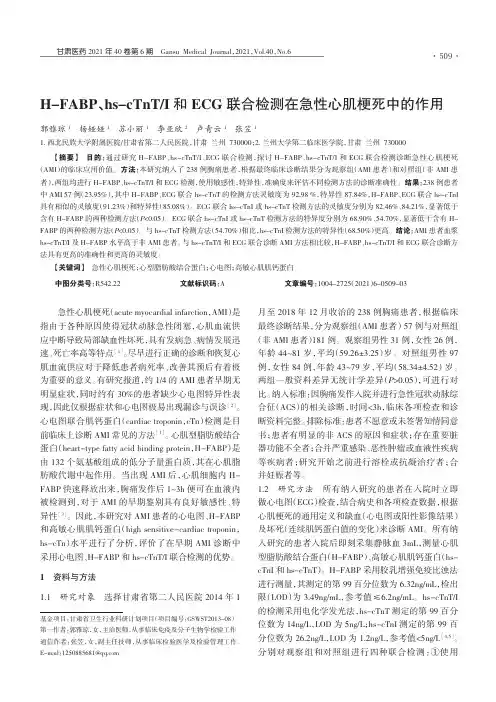
甘肃医药2021年40卷第6期Gansu Medical Journal ,2021,Vol.40,No.6急性心肌梗死(acute myocardial infarction ,AMI )是指由于各种原因使得冠状动脉急性闭塞,心肌血流供应中断导致局部缺血性坏死,具有发病急、病情发展迅速、死亡率高等特点[1]。
尽早进行正确的诊断和恢复心肌血流供应对于降低患者病死率、改善其预后有着极为重要的意义。
有研究报道,约1/4的AMI 患者早期无明显症状,同时约有30%的患者缺少心电图特异性表现,因此仅根据症状和心电图极易出现漏诊与误诊[2]。
心电图联合肌钙蛋白(cardiac troponin ,cTn )检测是目前临床上诊断AMI 常见的方法[1]。
心肌型脂肪酸结合蛋白(heart-type fatty acid binding protein ,H-FABP )是由132个氨基酸组成的低分子量蛋白质,其在心肌脂肪酸代谢中起作用。
当出现AMI 后,心肌细胞内H-FABP 快速释放出来,胸痛发作后1~3h 便可在血液内被检测到,对于AMI 的早期鉴别具有良好敏感性、特异性[3]。
因此,本研究对AMI 患者的心电图、H-FABP 和高敏心肌肌钙蛋白(high sensitive-cardiac troponin ,hs-cTn )水平进行了分析,评价了在早期AMI 诊断中采用心电图、H-FABP 和hs-cTnT/I 联合检测的优势。
1资料与方法1.1研究对象选择甘肃省第二人民医院2014年1月至2018年12月收治的238例胸痛患者,根据临床最终诊断结果,分为观察组(AMI 患者)57例与对照组(非AMI 患者)181例。
观察组男性31例,女性26例,年龄44~81岁,平均(59.26±3.25)岁。
对照组男性97例,女性84例,年龄43~79岁,平均(58.34±4.52)岁。
两组一般资料差异无统计学差异(P >0.05),可进行对比。
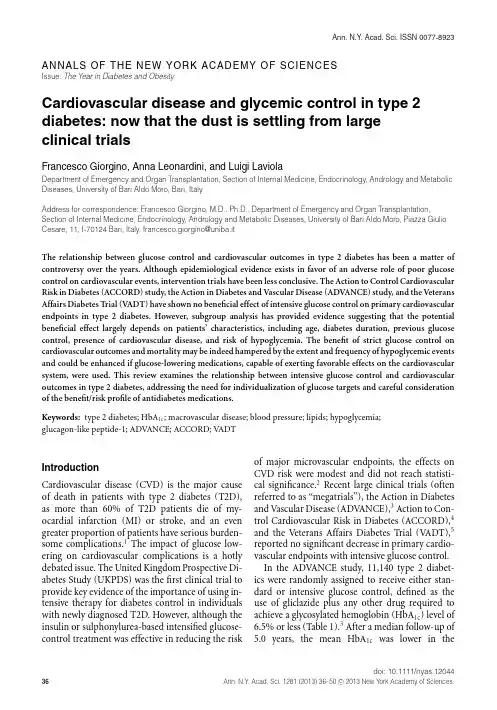
Ann.N.Y.Acad.Sci.ISSN0077-8923 ANNALS OF THE NEW YORK ACADEMY OF SCIENCESIssue:The Year in Diabetes and ObesityCardiovascular disease and glycemic control in type2 diabetes:now that the dust is settling from largeclinical trialsFrancesco Giorgino,Anna Leonardini,and Luigi LaviolaDepartment of Emergency and Organ Transplantation,Section of Internal Medicine,Endocrinology,Andrology and Metabolic Diseases,University of Bari Aldo Moro,Bari,ItalyAddress for correspondence:Francesco Giorgino,M.D.,Ph.D.,Department of Emergency and Organ Transplantation, Section of Internal Medicine,Endocrinology,Andrology and Metabolic Diseases,University of Bari Aldo Moro,Piazza Giulio Cesare,11,I-70124Bari,Italy.francesco.giorgino@uniba.itThe relationship between glucose control and cardiovascular outcomes in type2diabetes has been a matter of controversy over the years.Although epidemiological evidence exists in favor of an adverse role of poor glucose control on cardiovascular events,intervention trials have been less conclusive.The Action to Control Cardiovascular Risk in Diabetes(ACCORD)study,the Action in Diabetes and Vascular Disease(ADV ANCE)study,and the Veterans Affairs Diabetes Trial(V ADT)have shown no beneficial effect of intensive glucose control on primary cardiovascular endpoints in type2diabetes.However,subgroup analysis has provided evidence suggesting that the potential beneficial effect largely depends on patients’characteristics,including age,diabetes duration,previous glucose control,presence of cardiovascular disease,and risk of hypoglycemia.The benefit of strict glucose control on cardiovascular outcomes and mortality may be indeed hampered by the extent and frequency of hypoglycemic events and could be enhanced if glucose-lowering medications,capable of exerting favorable effects on the cardiovascular system,were used.This review examines the relationship between intensive glucose control and cardiovascular outcomes in type2diabetes,addressing the need for individualization of glucose targets and careful consideration of the benefit/risk profile of antidiabetes medications.Keywords:type2diabetes;HbA1c;macrovascular disease;blood pressure;lipids;hypoglycemia;glucagon-like peptide-1;ADV ANCE;ACCORD;V ADTIntroductionCardiovascular disease(CVD)is the major cause of death in patients with type2diabetes(T2D), as more than60%of T2D patients die of my-ocardial infarction(MI)or stroke,and an even greater proportion of patients have serious burden-some complications.1The impact of glucose low-ering on cardiovascular complications is a hotly debated issue.The United Kingdom Prospective Di-abetes Study(UKPDS)was thefirst clinical trial to provide key evidence of the importance of using in-tensive therapy for diabetes control in individuals with newly diagnosed T2D.However,although the insulin or sulphonylurea-based intensified glucose-control treatment was effective in reducing the risk of major microvascular endpoints,the effects on CVD risk were modest and did not reach statisti-cal significance.2Recent large clinical trials(often referred to as“megatrials”),the Action in Diabetes and Vascular Disease(ADV ANCE),3Action to Con-trol Cardiovascular Risk in Diabetes(ACCORD),4 and the Veterans Affairs Diabetes Trial(V ADT),5 reported no significant decrease in primary cardio-vascular endpoints with intensive glucose control. In the ADV ANCE study,11,140type2diabet-ics were randomly assigned to receive either stan-dard or intensive glucose control,defined as the use of gliclazide plus any other drug required to achieve a glycosylated hemoglobin(HbA1c)level of 6.5%or less(Table1).3After a median follow-up of 5.0years,the mean HbA1c was lower in thedoi:10.1111/nyas.12044Giorgino et al.Intensive glucose control and cardiovascular risk Table1.Age,diabetes duration,median follow-up,HbA1c values,and outcomes in the ACCORD and ADV ANCE studies and the V ADTDiabetes HbA1c(%):duration(year):Median intensive Primary All-cause Age intensive follow-up History versus endpoint HR mortality HR Study(year)versus standard(year)of CVD standard Primary endpoint(95%CI)(95%CI)ACCORD(n=10,251)62.2±6.810vs.10 3.435% 6.4vs.7.5Nonfatal MI,nonfatalstroke,or death fromCVD0.90(0.78–1.04) 1.22(1.01–1.46)ADV ANCE (n=11,140)66±6.08.0±6.4vs.7.9±6.35.032%6.53±0.91vs.7.30±1.26Death fromcardiovascular causes,nonfatal MI,ornonfatal stroke0.94(0.84–1.06)0.93(0.83–1.06)V ADT(n=1,791)60±9.011.5±8vs.11.5±75.640%6.9vs.8.4MI,stroke,death fromCVD,CHF,surgery forvascular disease,inoperable CAD,oramputation forischemic gangrene0.88(0.74–1.05) 1.07(0.81–1.42)intensive control group(6.5%vs.7.3%),with a reduction in the incidence of combined major macrovascular and microvascular events primarily because of a reduction in the incidence of nephropa-thy.There were no significant effects of the inten-sive glucose control on major macrovascular events, death from cardiovascular causes,or death from any cause.Similarly,in the V ADT,1,791suboptimally controlled type2diabetics,40%with established CVD,were randomized to receive either intensive glucose control,targeting an absolute reduction of 1.5%in HbA1c levels,or standard glucose control (Table1).5After a median follow-up of5.6years, HbA1c was lower in the intensive-therapy group (6.9%vs.8.4%).Nevertheless,there was no sig-nificant difference between the two groups in the incidence of major cardiovascular events,or in the rate of death from any cause.ACCORD was another study designed to determine whether intensive glu-cose control would reduce the rate of cardiovas-cular events(Table1).4In this study,10,251type 2diabetics with median baseline HbA1c of8.1% were randomly assigned to receive either intensive therapy targeting an HbA1c level within the normal range,that is,below6.0%,or standard therapy tar-geting HbA1c between7.0%and7.9%.The primary outcome was a composite of nonfatal MI,nonfatal stroke,or death from cardiovascular causes.Even though the rate of nonfatal MI was significantly lower in the intensive therapy arm,thefinding of higher all-cause and cardiovascular cause mortal-ity in this group led to discontinuation of the in-tensive therapy after a mean follow-up of3.5years (Fig.1).Notably,hypoglycemia requiring assistance and weight gain of more than10kg were more fre-quent in the intensive therapy group.The results of the ACCORD study raised concern about not only the effectiveness but also the safety of inten-sive glycemic control in type2diabetics.Prespec-ified subgroup analysis of the participants in this trial suggested that patients in the intensive group without history of cardiovascular event before ran-domization or whose baseline HbA1c level was8.0% or less may have had fewer fatal or nonfatal car-diovascular events than did patients in the standard therapy group.Several recent meta-analyses of randomized con-trolled trials have also investigated the effects of intensive glucose lowering on all-cause mortal-ity,cardiovascular death,and vascular events in T2D.6–10In the largest and most recent meta-analysis by Boussageon et al.,13studies were in-cluded.6Of the34,533patients evaluated,18,315 received intensive glucose-lowering treatment and 16,218standard treatment.Intensive treatment did not significantly affect all-cause mortality or cardiovascular death.The results of this meta-analysis showed limited benefit of intensive glucose-lowering therapy on all-cause mortality and deaths from cardiovascular causes,and a10%reduction in the risk of microalbuminuria.6Results from other meta-analyses have also shown no effects ofIntensive glucose control and cardiovascular risk Giorgino etal.Figure 1.Effects of intensive glucose control on all-cause and cardiovascular mortality and myocardial infarction in the ACCORD study.CV,cardiovascular.∗P<0.05.Adapted from Ref.4.intensive glucose control on all-cause or cardiovas-cular mortality,while indicating a modest15–17% reduction in the incidence of nonfatal MI in these cohorts.7–10Several potential factors could have contributed to limit the potential benefit of intensive glucose-lowering therapies on CVD prevention in T2D in-dividuals in studies such as the ACCORD and AD-V ANCE and the V ADT:(1)Concomitant targeting of other potentiallymore potent cardiovascular risk factors,suchas blood pressure and lipids,might havedampened the favorable effects of controllinghyperglycemia.(2)Intensive control of hyperglycemia could havebeen directed to patients unable to exhibit theexpected benefit due to their specific clinicalcharacteristics(“wrong”patients).(3)Limited benefit might have derived from usingglucose-lowering drugs with no favorable im-pact on the global cardiovascular risk profile.(4)Glucose-lowering drugs might have producedadverse effects on the cardiovascular systemby inducing weight gain and hypoglycemicevents,resulting in somewhat increased riskfor CVD and mortality(“imperfect”drugs).(5)Excess mortality might have potentially re-sulted from using too many drugs and/or toocomplex drug regimens,leading to undesir-able drug–drug interactions with a potentiallyharmful impact on patients’health.These diverse factors and their potential role in the relationship between intensive glucose control and CVD/mortality are outlined in Figure2,and will be discussed individually below.Limited benefit due to other therapies Although several studies have focused on intensive glycemic control to decrease the risks of macrovas-cular and microvascular diseases in T2D,glucose control is only one of the factors to be considered. Comprehensive risk factor management,including blood pressure control,lipid management,weight reduction in overweight or obese individuals,and smoking cessation,are also needed.The results of the ACCORD and ADV ANCE studies and the V ADT should be interpreted in the context of comprehen-sive care of patients with diabetes.Interventions for simultaneous optimal control of comorbidities of-ten present in type2diabetics,such as hyperten-sion and hyperlipidemia,have been shown to be a more effective strategy in reducing cardiovascular risk than targeting only blood glucose levels per se.11 Evidence for an aggressive approach to lipid and blood pressure control was supported by the re-sults from the Steno-2study.11,12In Steno-2,inves-tigators used intensified multifactorial intervention with improved glycemia,renin–angiotensin system blockers,aspirin,and lipid-lowering agents and evaluated whether this approach would have an ef-fect on the rates of death from cardiovascular causes and from any cause.11,12The primary endpoint at 13.3years of follow-up was the time to death from any cause.Intensive therapy was also associated with a significantly lower risk of death from cardiovascu-lar causes and of cardiovascular events.The Steno-2study did demonstrate a difference in levels of glycemia achieved when compared with the AC-CORD study:4,11HbA1c was a mean of8.4%at study entry and7.9%at end of study intervention for the intensively treated group,whereas it was8.8%at baseline and9.0%at study end for conventional treatment.In addition,only a limited proportion of subjects in the intensively treated group reached an HbA1c level of less than6.5%(i.e.,∼15%),and this proportion was not statistically different than in the conventionally treated group,indicating poor success in achieving the prespecified glucose target and somewhat reducing the relevance of the spe-cific intervention on the hyperglycemia component for CVD and microvascular disease prevention.The observational study has continued,and the differ-ences observed in glycemia between intensive andGiorgino et al.Intensive glucose control and cardiovascularriskFigure2.Relationship between intensive glucose control and cardiovascular outcomes and mortality in the ACCORD study and other megatrials.The potential mechanisms affecting this relationship and limiting the clinical benefit are outlined in the box on the left.CV,cardiovascular;CVD,cardiovascular disease.conventional treatments are much less than at endof intervention.Nevertheless,over the long-termperiod of follow-up,intensive intervention with avaried drug regimen and lifestyle modification hadsustained beneficial effects with respect to vascularcomplications and rates of death from any cause andfrom cardiovascular causes.12Blood pressureThe ACCORD study also had an embedded bloodpressure trial that examined whether blood pressurelowering to systolic blood pressure(SBP)less than120mm Hg provided greater cardiovascular protec-tion than a SBP of130–140mm Hg in T2D patientsat high risk for CVD.13A total of4,733participantswere randomly assigned to intensive therapy(SBP <120mm Hg)or standard therapy(SBP<140mm Hg),with the mean follow-up being4.7years.Theblood pressure levels achieved in the intensive andstandard groups were119/64mm Hg and133/70mm Hg,respectively;this difference was attainedwith an average of3.4medications per participantin the intensive group and2.1in the standard ther-apy group.The intensive antihypertensive therapyin the ACCORD blood pressure trial did not consid-erably reduce the primary cardiovascular outcomeor the rate of death from any cause.However,theintensive arm of blood pressure control reduced therate of total stroke and nonfatal stroke,with the estimated number needed to treat with intensive blood pressure therapy to prevent one stroke over five years being89.There were indicators of possi-ble harm associated with intensive blood pressure lowering(SBP<120mm Hg),including a rate of serious adverse events in the intensive arm.It should be noted that of the subjects investigated in the ACCORD glucose control trial∼85%were on antihypertensive medications,and their blood pres-sure levels were126.4/66.9and127.4/67.7in the intensive and standard groups,respectively,a differ-ence that was statistically significant(P<0.001) (Table2).4Thus,the effects of intensive glucose lowering on the CVD and other outcomes were ex-amined in a context in which blood pressure was being actively targeted,with possible differences between the intensively and conventionally treated cohorts.The ADV ANCE study also included a blood pres-sure intervention trial.In this study,treatment with an angiotensin converting enzyme(ACE)inhibitor and a thiazide-type diuretic reduced the rate of death but not the composite macrovascular out-come.However,this trial had no specified targets for the randomized comparison,and the mean SBP in the intensive group(135mm Hg)was not as low as the mean SBP in the ACCORD standard-therapy group.14However,a post hoc analysis of blood pres-sure control in6,400patients with diabetes andIntensive glucose control and cardiovascular risk Giorgino et al. Table2.Blood pressure and lipid levels and use of statin,antihypertensive medications,and aspirin in the ACCORD and ADV ANCE studies and the V ADT participants at study end(adapted from Refs.3–5)ACCORD(n=10,251)aADV ANCE(n=11,140)b V ADT(n=1,791)cStandard Intensive Standard Intensive Standard Intensive Blood pressure(mm Hg)Systolic128±16126±17137±18135±17125±15127±16 Diastolic68±1067±1074±1073±1069±1068±10 Cholesterol(mg/dL)LDL87±3387±33103±41102±3880±3180±33 HDL49±13(♂)49±13(♂)48±1448±1441±1240±1140±11(♀)40±10(♀)Total164±42163±42153±40150±40 Triglycerides(mg/dL)166±114160±125161±102151±94159±104151±173 On statin(%)888848468385 On antihypertensivemedications(%)858389887576 On aspirin(%)767655578586a Intensive(target HbA1c<6%)vs.standard(HbA1c7–7.9%).b Intensive(target HbA1c<6.5%)vs.standard(HbA1c>6.5%).c Intensive(target HbA1c4.8–6.0%)vs.standard(HbA1c8–9.0%).Abbreviations:HDL,high-density lipoprotein;LDL,low-density lipoprotein;♂,men;♀,women.coronary artery disease enrolled in the International Verapamil/Trandolapril Study(INVEST)demon-strated that tight control(<130mm Hg)was not associated with improved cardiovascular outcomes compared with usual care(130–140mm Hg).15In the V ADT,blood pressure,lipids,diet,and lifestyle were treated identically in both arms.By improving blood pressure control in an identical manner in both glucose arms,the V ADT excluded the effect of blood pressure differences on cardiovas-cular events between treatment arms and reduced the overall risk of macrovascular complications dur-ing the trial.5Participants in the V ADT(n=1,791) with hypertension(72.1%of total)received stepped treatment to maintain blood pressure below the tar-get of130/80mm Hg in standard and intensive glycemic treatment groups.Blood pressure levels of all subjects at baseline and on-study were analyzed to detect associations with cardiovascular risk.The primary outcome was the time from randomiza-tion to thefirst occurrence of MI,stroke,conges-tive heart failure,surgery for vascular disease,in-operable coronary disease,amputation for ischemic gangrene,or cardiovascular death.From data analy-sis,increased risk of cardiovascular events with SBP ≥140mm Hg emphasizes the need for treatment of systolic hypertension.Also,this study for the first time demonstrated that diastolic blood pressure (DBP)<70mm Hg in T2D patients was indepen-dently associated with elevated cardiovascular risk, even when SBP was on target.16Lipid profileIt has been widely demonstrated that intensive targeting of low-density lipoprotein(LDL)choles-terol contributes to CVD prevention in T2D.As a consequence,most guidelines suggest a target LDL-cholesterol level below100mg/dL as the primary goal in T2D individuals,with the option of achieving an LDL-cholesterol level below70mg/dL in those with overt CVD.Regarding the overall lipid-lowering approach in the ACCORD glucose control study,it should be observed that mean LDL cholesterol was below90mg/dL in both the intensive and standard glucose control arms,and that88%of subjects were on statin therapy.4Thus, the results from this study do not clarify whether lipid control and glycemic control,respectively,areGiorgino et al.Intensive glucose control and cardiovascularriskFigure3.All-cause mortality in intensive versus standard glycemia groups according to use of antihypertensive medications, statins,and aspirin in the ACCORD and ADV ANCE studies.∗P=0.0305for subjects on aspirin versus subjects not on aspirin. Adapted from Refs.3and18.related or synergistic,since the large majority of enrolled subjects were already receiving a lipid control regimen.Data from the Steno-2trial on combined control of glucose,lipids,and blood pressure levels demonstrated significant short-and long-term benefits from this multifactorial approach.11In the study,the effect seemed to be cumulative rather than synergistic.Recent results from the ACCORD-LIPID study indicate that intensive lipid control(i.e.,addition of afibrate to statin therapy)does not reduce car-diovascular events.17Specifically,the lipid-lowering arm of ACCORD failed to demonstrate any ben-efit of add-on therapy with fenofibrate to LDL-lowering treatment with HMG-CoA reductase in-hibitors(statins)on vascular outcomes in patients with diabetes.However,data from earlier studies and from a subgroup analysis of ACCORD indi-cate a probable benefit of adding treatment with fibric acid derivatives to individuals with persis-tently elevated triglyceride levels and low high-density lipoprotein(HDL)cholesterol despite statin therapy.17In the ACCORD and ADV ANCE studies and the V ADT,a large proportion of subjects,ranging from55%to85%,were also treated with aspirin (Table2).Thus,results from ADV ANCE,ACCORD, and V ADT suggest that a large proportion of par-ticipants in these trials,which were being treated intensively or less intensively for glucose targets, received extensive antihypertensive,lipid-lowering, and antiplatelet medications.Median levels of SBP, SDP,and LDL cholesterol in these cohorts were also indicative of a significant proportion of them be-ing adequately controlled for blood pressure and lipid targets(Table2).Therefore,the possibility ex-ists that active interventions for simultaneous con-trol of hypertension and hyperlipidemia and use of aspirin may have affected the impact of intensive glucose control on cardiovascular outcomes in the megatrials.Subgroups analyses,however,do not ap-parently support this conclusion(Fig.3).Whether patients were on antihypertensive or lipid-lowering medications was not associated with a different out-come of the intensive glucose control on mortality in ACCORD and ADV ANCE patients,even thoughIntensive glucose control and cardiovascular risk Giorgino et al.the different groups were largely unbalanced in size. Only aspirin use in the ACCORD study seemed to modulate the effects of intensive versus standard glucose control on mortality.18The“wrong patient”concept and the need for individualization of glucose targets The ADV ANCE and ACCORD studies and the V ADT provide conflicting evidence of mortality risk with intensive glycemic control.These trials showed an approximate15%reduction in nonfatal MI with no benefit or harm in all-cause or cardiovascular mortality.Potential explanations for the lack of im-pact of intensive glycemic control on CVD can be found in the patients’characteristics.Indeed,these studies were of shorter duration and enrolled gener-ally older patients than previous studies,including the DCCT and UKPDS in which the intensive con-trol had shown better outcomes.In addition,mean diabetes duration was longer and a greater portion of patients had established CV disease in the mega-trials(approximately32–40%)than in earlier trials (Table1).It is also possible that the follow-up of these studies was too short to detect a clinical ben-efit.Consistent with this hypothesis,in the UKPDS no macrovascular benefit was noted in the inten-sive control arm in thefirst10years of follow-up. Nevertheless,posttrial monitoring for an additional 10years(UKPDS80)revealed a15%risk reduction in MI and13%reduction in all-cause mortality in the intensive treatment group.19A possible explanation is that the wrong patients were investigated in the megatrials(Fig.2).Indeed, the population of the ACCORD study may not rep-resent the average patient with T2D in clinical prac-tice.Participants in this trial had T2D on average for10years at the time of enrollment,had higher HbA1c levels than most type2diabetic patients in the United States and most Western countries to-day(average of8.2%at baseline),and had known heart disease or at least two risk factors in addi-tion to diabetes,such as high blood pressure,high cholesterol levels,obesity,and smoking.4In the UKPDS,the benefits of intensive glycemic control on CVD were observed only after a long duration of intervention in newly diagnosed younger patients.2 In older patients with T2D with longer disease dura-tion,atherosclerotic disease may already have been established and thus intensive glucose control may have had little benefit.Conversely,patients with shorter disease duration,lower HbA1c,and/or lack of established CVD might have benefited signifi-cantly from more intensive glycemic control.20,21 Relevant to this concept,the V ADT showed that ad-vanced CVD,as demonstrated by computed tomog-raphy(CT)-detectable coronary artery calcium,was associated with negative outcomes.In a substudy co-hort of301T2D participants in V ADT,the ability of intensive glucose therapy compared with standard therapy to reduce cardiovascular events was exam-ined based on the extent of coronary atherosclerosis as measured by a CT-detectable coronary artery cal-cium score(CAC).The data showed that there was a progressive diminution of the benefit of intensive glucose control with increasing CAC.In patients with CAC≤100,1of52individuals experienced an event(HR for intensive therapy=0.08;range, 0.008–0.770;P=0.03),whereas11of62patients with a CAC>100had an event(HR=0.74;range, 0.46–1.20;P=0.21).Thus,this subgroup analy-sis indicates that intensive glycemic therapy may be most effective in those with less extensive coronary atherosclerosis.22Why does intensive treatment of hyperglycemia appear to be ineffective in reducing cardiovascular events in T2D with advanced atherosclerosis?Two potential mechanisms may be involved.First,once the atherosclerotic plaque has developed,modified lipoproteins,activated vascular cells,and altered im-mune cell signaling may generate a self-propagating process that maintains atherogenesis,even in the face of improved glucose control.Second,advanced glycosylation end-product formation,which may be involved in CVD,is not readily reversible and may require more than three tofive years of in-tensive glucose control to be reverted.Thus,the presence of multiple cardiovascular risk factors or established CVD may have reduced the benefits of intensive glycemic control in the high-risk cohort of ACCORD,ADV ANCE,and V ADT compared with the low-risk population of the UKPDS cohort,of whom only a minority had prior CVD.23The pres-ence of long-standing disease and prolonged prior poor glycemic control may be additional factors ac-celerating the progression of atherosclerotic lesions in T2D.The goal of individualizing HbA1c targets has gained more attraction after these recent clinical trials in older patients with established T2D failed to show a benefit from intensive glucose-loweringGiorgino et al.Intensive glucose control and cardiovascular riskTable3.Potential criteria for individualization of glucose targets in type2diabetes2–5,25,29HbA1c HbA1c Criterion<6.5–7.0%7.0–8.0% Age(years)<55>60 Diabetes duration(years)<10>10Life expectancy(years)>5<5 Possibility to performIGC for>5yearsYes No Usual HbA1c level(%)<8.0>8.0 CVD No Yes Prone to hypoglycemia No No Reduction of HbA1clevel upon IGCYes NoAbbreviations:CVD,cardiovascular disease;IGC,in-tensive glucose control.therapies on CVD outcomes.Recommendations suggest that the goals should be individualized,such that(1)certain populations(children,pregnant women,and elderly patients)require special con-siderations and(2)more stringent glycemic goals (i.e.,a normal HbA1c<6.0%)may further re-duce complications at the cost of increased risk of hypoglycemia.24For the latter,the recommen-dations also suggest that less intensive glycemic goals may be indicated in patients with severe or frequent hypoglycemia.With regard to the less intensive glycemic goals,perhaps consideration should be given to the high-risk patient with mul-tiple risk factors and CVD,as evaluated in the ACCORD study.4Thus,aiming for a HbA1c of 7.0–8.0%may be a reasonable goal in patients with very long duration of diabetes,history of se-vere hypoglycemia,advanced atherosclerosis,sig-nificant comorbidities,and advanced age/frailty (Table3),even though with what priority each one of these criteria should be considered is not clear at present(current recommendations from scientific societies also do not provide this spe-cific information).In younger patients without documented macrovascular disease or the above-mentioned conditions,the goal of attaining an HbA1c<6.5–7.0%may provide long-lasting bene-fits.In patients with limited life expectancy,more liberal HbA1c values may be pursued.In deter-mining the HbA1c target for CVD prevention,one should consider that at least three tofive years are usually required before possible differences in the incidence of nonfatal MI in T2D are observed.2 Thus,a clinical setting that allows tight glucose control to be implemented for this period of time should be available.Finally,an excess mortality was observed in the ACCORD study in those T2D in-dividuals who showed an unexpected increase in HbA1c levels upon institution of intensive glucose control.25Accordingly,patients exhibiting the pat-tern of worsening glycemic control when exposed to intensive treatment should be set at higher glucose targets(Table3).The above guidelines are apparently incorpo-rated into the updated version of the American Diabetes Association and the European Associa-tion for the Study of Diabetes recommendations on the management of hyperglycemia in nonpreg-nant adults with T2D.The new recommendations are less prescriptive and more patient centered.In-dividualized treatment is explicitly defined as the cornerstone of success.Treatment strategies should be tailored to individual patient needs,preferences, and tolerances and based on differences in age and disease course.Other factors affecting individual-ized treatment plans include specific symptoms,co-morbid conditions,weight,race/ethnicity,sex,and lifestyle.26Current“imperfect”glucose-lowering drugsThe inability of ACCORD,ADV ANCE,and V ADT to demonstrate significant reductions in CVD out-comes with intensive glycemic control also suggests that current pharmacological tools for treating hy-perglycemia in patients with more advanced T2D may have counterbalancing consequences for the cardiovascular system.The available agents used to treat diabetes have not been conclusively shown to reduce macrovascular disease and,in some in-stances,their chronic use may promote negative cardiovascular effects in diabetic subjects despite improvement of hyperglycemia.Importantly,these adverse cardiovascular side effects appear in several instances to be directly due to the mode of drug ac-tion.Selection of a treatment regimen for patients with T2D includes evaluation of the effects of med-ications on overall cardiovascular risk.27 Sulfonylureas have the benefit of acting rapidly to lower glucose levels but,unfortunately,on a。
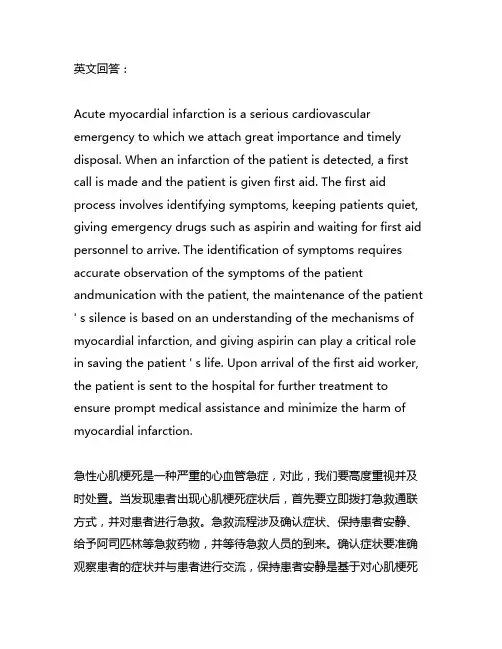
英文回答:Acute myocardial infarction is a serious cardiovascular emergency to which we attach great importance and timely disposal. When an infarction of the patient is detected, a first call is made and the patient is given first aid. The first aid process involves identifying symptoms, keeping patients quiet, giving emergency drugs such as aspirin and waiting for first aid personnel to arrive. The identification of symptoms requires accurate observation of the symptoms of the patient andmunication with the patient, the maintenance of the patient ' s silence is based on an understanding of the mechanisms of myocardial infarction, and giving aspirin can play a critical role in saving the patient ' s life. Upon arrival of the first aid worker, the patient is sent to the hospital for further treatment to ensure prompt medical assistance and minimize the harm of myocardial infarction.急性心肌梗死是一种严重的心血管急症,对此,我们要高度重视并及时处置。
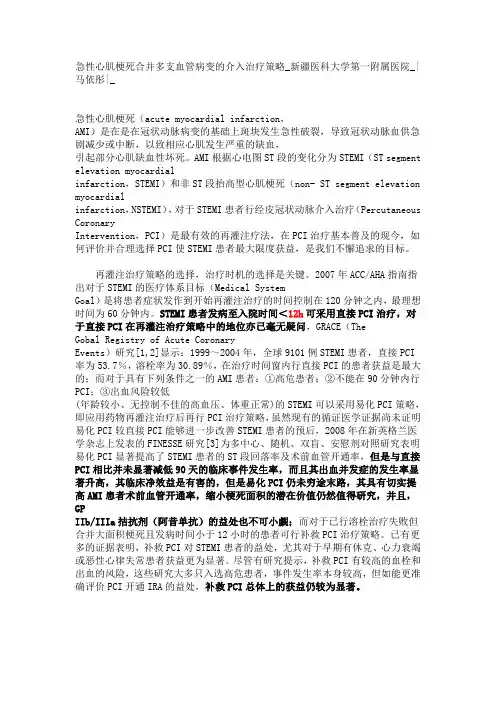
急性心肌梗死合并多支血管病变的介入治疗策略_新疆医科大学第一附属医院_|马依彤|_急性心肌梗死(acute myocardial infarction,AMI)是在是在冠状动脉病变的基础上斑块发生急性破裂,导致冠状动脉血供急剧减少或中断,以致相应心肌发生严重的缺血,引起部分心肌缺血性坏死。
AMI根据心电图ST段的变化分为STEMI(ST segment elevation myocardialinfarction,STEMI)和非ST段抬高型心肌梗死(non- ST segment elevation myocardialinfarction,NSTEMI),对于STEMI患者行经皮冠状动脉介入治疗(Percutaneous CoronaryIntervention,PCI)是最有效的再灌注疗法,在PCI治疗基本普及的现今,如何评价并合理选择PCI使STEMI患者最大限度获益,是我们不懈追求的目标。
再灌注治疗策略的选择,治疗时机的选择是关键。
2007年ACC/AHA指南指出对于STEMI的医疗体系目标(Medical SystemGoal)是将患者症状发作到开始再灌注治疗的时间控制在120分钟之内,最理想时间为60分钟内。
STEMI患者发病至入院时间<12h可采用直接PCI治疗,对于直接PCI在再灌注治疗策略中的地位亦已毫无疑问,GRACE(TheGobal Registry of Acute CoronaryEvents)研究[1,2]显示:1999~2004年,全球9101例STEMI患者,直接PCI 率为53.7%,溶栓率为30.89%,在治疗时间窗内行直接PCI的患者获益是最大的;而对于具有下列条件之一的AMI患者:①高危患者;②不能在90分钟内行PCI;③出血风险较低(年龄较小、无控制不佳的高血压、体重正常)的STEMI可以采用易化PCI策略,即应用药物再灌注治疗后再行PCI治疗策略,虽然现有的循证医学证据尚未证明易化PCI较直接PCI能够进一步改善STEMI患者的预后,2008年在新英格兰医学杂志上发表的FINESSE研究[3]为多中心、随机、双盲、安慰剂对照研究表明易化PCI显著提高了STEMI患者的ST段回落率及术前血管开通率,但是与直接PCI相比并未显著减低90天的临床事件发生率,而且其出血并发症的发生率显著升高,其临床净效益是有害的,但是易化PCI仍未穷途末路,其具有切实提高AMI患者术前血管开通率,缩小梗死面积的潜在价值仍然值得研究,并且,GPIIb/IIIa拮抗剂(阿昔单抗)的益处也不可小觑;而对于已行溶栓治疗失败但合并大面积梗死且发病时间小于12小时的患者可行补救PCI治疗策略。
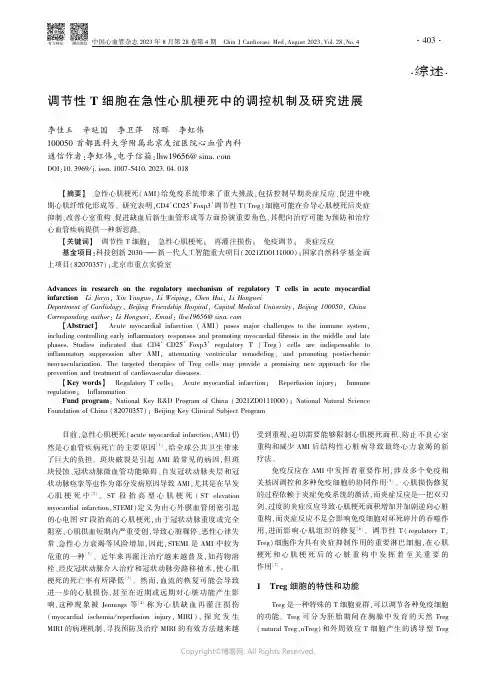
㊃综述㊃调节性T细胞在急性心肌梗死中的调控机制及研究进展李佳玉㊀辛延国㊀李卫萍㊀陈晖㊀李虹伟100050首都医科大学附属北京友谊医院心血管内科通信作者:李虹伟,电子信箱:lhw19656@DOI:10.3969/j.issn.1007-5410.2023.04.018㊀㊀ʌ摘要ɔ㊀急性心肌梗死(AMI)给免疫系统带来了重大挑战,包括控制早期炎症反应㊁促进中晚期心肌纤维化形成等㊂研究表明,CD4+CD25+Foxp3+调节性T(Treg)细胞可能在介导心肌梗死后炎症抑制㊁改善心室重构㊁促进缺血后新生血管形成等方面扮演重要角色,其靶向治疗可能为预防和治疗心血管疾病提供一种新思路㊂ʌ关键词ɔ㊀调节性T细胞;㊀急性心肌梗死;㊀再灌注损伤;㊀免疫调节;㊀炎症反应基金项目:科技创新2030 新一代人工智能重大项目(2021ZD0111000);国家自然科学基金面上项目(82070357);北京市重点实验室Advances in research on the regulatory mechanism of regulatory T cells in acute myocardialinfarction㊀Li Jiayu,Xin Yanguo,Li Weiping,Chen Hui,Li HongweiDepartment of Cardiology,Beijing Friendship Hospital,Capital Medical University,Beijing100050,ChinaCorresponding author:Li Hongwei,Email:lhw19656@ʌAbstractɔ㊀Acute myocardial infarction(AMI)poses major challenges to the immune system,including controlling early inflammatory responses and promoting myocardial fibrosis in the middle and late phases.Studies indicated that CD4+CD25+Foxp3+regulatory T(Treg)cells are indispensable to inflammatory suppression after AMI,attenuating ventricular remodeling,and promoting postischemic neovascularization.The targeted therapies of Treg cells may provide a promising new approach for the prevention and treatment of cardiovascular diseases.ʌKey wordsɔ㊀Regulatory T cells;㊀Acute myocardial infarction;㊀Reperfusion injury;㊀Immune regulation;㊀InflammationFund program:National Key R&D Program of China(2021ZD0111000);National Natural Science Foundation of China(82070357);Beijing Key Clinical Subject Program㊀㊀目前,急性心肌梗死(acute myocardial infarction,AMI)仍然是心血管疾病死亡的主要原因[1],给全球公共卫生带来了巨大的负担㊂斑块破裂是引起AMI最常见的病因,但斑块侵蚀㊁冠状动脉微血管功能障碍㊁自发冠状动脉夹层和冠状动脉痉挛等也作为部分发病原因导致AMI,尤其是在早发心肌梗死中[2]㊂ST段抬高型心肌梗死(ST elevation myocardial infarction,STEMI)定义为由心外膜血管闭塞引起的心电图ST段抬高的心肌梗死,由于冠状动脉重度或完全阻塞,心肌供血短期内严重受创,导致心脏骤停㊁恶性心律失常㊁急性心力衰竭等风险增加,因此,STEMI是AMI中较为危重的一种[3]㊂近年来再灌注治疗越来越普及,如药物溶栓㊁经皮冠状动脉介入治疗和冠状动脉旁路移植术,使心肌梗死的死亡率有所降低[1]㊂然而,血流的恢复可能会导致进一步的心肌损伤,甚至在近期或远期对心脏功能产生影响,这种现象被Jennings等[4]称为心肌缺血再灌注损伤(myocardial ischemia/reperfusion injury,MIRI),探究发生MIRI的病理机制㊁寻找预防及治疗MIRI的有效方法越来越受到重视,迫切需要能够限制心肌梗死面积㊁防止不良心室重构和减少AMI后结构性心脏病导致最终心力衰竭的新疗法㊂免疫反应在AMI中发挥着重要作用,涉及多个免疫相关基因调控和多种免疫细胞的协同作用[5]㊂心肌损伤修复的过程依赖于炎症免疫系统的激活,而炎症反应是一把双刃剑,过度的炎症反应导致心肌梗死面积增加并加剧逆向心脏重构,而炎症反应不足会影响免疫细胞对坏死碎片的吞噬作用,进而影响心肌组织的修复[6]㊂调节性T(regulatory T, Treg)细胞作为具有炎症抑制作用的重要淋巴细胞,在心肌梗死和心肌梗死后的心脏重构中发挥着至关重要的作用[7]㊂1㊀Treg细胞的特性和功能Treg是一种特殊的T细胞亚群,可以调节各种免疫细胞的功能㊂Treg可分为胚胎期间在胸腺中发育的天然Treg (natural Treg,nTreg)和外周效应T细胞产生的诱导型Treg(inducible Treg,iTreg)㊂Treg可调节不同的免疫反应,其中天然的CD4+CD25+Foxp3+Treg是最重要的Treg细胞亚群㊂Treg主要作用是参与调节机体免疫耐受,终止激活的免疫反应,控制炎症和维持免疫稳态,主要通过以下几种机制实现:(1)分泌抗炎因子,如白细胞介素(interleukin,IL)-10㊁IL-35和转化生长因子β(transforming growth factor-beta,TGF-β);(2)环磷酸腺苷(cAMP)㊁CD39和CD73破坏代谢;(3)抑制抗原呈递细胞成熟;(4)IL-2的消耗,颗粒酶和穿孔素致细胞溶解,诱导效应T细胞死亡;(5)Treg表达共抑制受体,包括细胞毒性T淋巴细胞相关蛋白4(cytotoxic T lymphocyte-associated protein4,CTLA-4)和程序性细胞死亡蛋白1配体(programmed death protein ligand-1,PD-L1),进一步支持Treg免疫调节特性[8]㊂由于它能减少炎症和调节免疫系统,目前正在探索使用Treg细胞作为治疗自身免疫性疾病的新型疗法[9]㊂2㊀Treg细胞在AMI中的分布和调节2.1㊀外周血Treg细胞分布特点与稳定型心绞痛患者相比,急性冠状动脉综合征(acute coronary syndrome,ACS)患者的外周血中Treg水平较低[10],这可能是由于整体Treg缺陷或由血液向炎症部位的趋化所致㊂然而,另有研究表明STEMI患者的外周血Treg增加,而除STEMI以外的其他ACS患者的外周血Treg水平减少,推测这样的差异可能取决于部分人群CD28发生无效突变,而CD28无效突变T细胞水平的增加可能影响Treg细胞的稳态和存活[11]㊂最近一项研究对GEO数据库中的6个数据集进行了机器学习和分析发现,AMI组血液样本中巨噬细胞㊁中性粒细胞和Treg细胞的比例显著高于正常组[12],然而考虑到其样本是在AMI后7d内获得的,并非所有样本都是在24~72h 内获得的,因此推测全身炎症反应的峰值可能已克服了代偿机制㊂我们分析,这些结果的差异与血液样本采集时间㊁实验方法和基于流式细胞术的Treg细胞鉴定的质量有关㊂2.2㊀心肌组织Treg细胞募集特点Treg在多种疾病的器官炎症反应部位浸润㊂MI在病理学上被定义为心肌细胞因长时间缺血而死亡,这可能是由动脉粥样硬化斑块破裂㊁供氧中断或心肌需氧量增加引起的[13]㊂MI可根据临床特征和病理表现在时间上分为急性期(6h至6d)㊁愈合期(7~28d)和愈合后期(>29d)三个阶段㊂从免疫学角度来看,MI可被视为缺血背景下的无菌性组织损伤,导致损伤相关分子模式的启动和自身抗原的迅速释放㊂在MI急性期,CD4+T细胞被募集到梗死区和引流心脏的纵隔淋巴结㊂与自身免疫性心肌炎不同,在MI急性期出现的CD4+T细胞反应大多是有益的,似乎有助于组织修复㊂大鼠MI模型证实了心脏组织中Treg数量的增加,并且通过CD28超激动性抗体扩增体内Treg,可使心脏功能得到改善[14]㊂3㊀Treg细胞对AMI心肌细胞的调控机制3.1㊀炎症反应在AMI过程中,来源于脾脏的单核细胞/巨噬细胞的激活及其表型对于心肌愈合至关重要,促炎和抗炎之间的微妙平衡决定了其病理上的恢复与否㊂AMI后,中性粒细胞群会在数小时内募集到心肌损伤部位,然后单核细胞/巨噬细胞根据损伤程度跟随中性粒细胞的募集㊂AMI后第3~7天中性粒细胞和巨噬细胞富集易引起过度的炎症反应并导致不良并发症㊂AMI后Treg浸润心肌组织,主要分泌抑制性炎症因子,如IL-10和TGF-β,抑制巨噬细胞和淋巴细胞的炎症反应,从而有效减少促炎细胞因子如IL-1β㊁IL-6和肿瘤坏死因子α(tumor necrosis factor-α,TNF-α)的分泌,减少了AMI 的心肌损伤㊂AMI的血运重建涉及另一重要病理生理过程,即再灌注损伤,其诱导的炎症反应涉及中性粒细胞浸润和巨噬细胞M1极化㊂Treg通过抑制免疫激活和建立免疫耐受机制来调节成熟T细胞反应,从而抑制炎症反应[15]㊂在心肌缺血再灌注模型中发现,Treg耗竭与炎症反应升高㊁基序趋化因子配体2(CCL2)产生和成纤维细胞功能降低有关㊂在MIRI 模型中选择性消耗Treg会导致损伤加重,而通过注射体外预激活的Treg可以弥补上述损伤,缓解心室重构[16],研究中证实其心肌保护作用需要完整的CD39(三磷酸外核苷二磷酸水解酶1)信号传导,这提示嘌呤代谢可能是心血管疾病中重要的调控Treg功能的机制㊂在血管紧张素Ⅱ/去氧肾上腺素诱导的心肌损伤模型中,由CCR2阳性单核细胞衍生的巨噬细胞产生的基序趋化因子配体17可抑制Treg向心脏组织的迁移[17]㊂在MIRI中,Treg已被证实可通过抑制基质金属蛋白酶2(MMP-2)的激活来抑制心肌细胞凋亡和细胞外基质重构,进而改善MIRI后的心脏功能[18]㊂MIRI临床前研究的结果表明了IL-10和TGF-β1在Treg和骨髓间充质干细胞改善心肌损伤中的重要性,而最新一项研究表明,接受体外回输骨髓间充质干细胞的MIRI小鼠表现出了炎症的减轻和细胞凋亡的下调[19]㊂总之,以上证据表明,Treg细胞通过多种机制抑制心肌局部炎症反应㊂3.2㊀心室重构与纤维化MI后心脏修复的特点是由先天免疫系统协调的一系列时间依赖性事件㊂在MI的急性炎症之后,进入修复和增殖阶段,肌成纤维细胞增殖,胶原沉积导致瘢痕形成是该阶段的重要特征㊂修复的炎症㊁增殖和成熟阶段的适当平衡和及时㊁适当的损伤愈合反应至关重要㊂研究表明,炎症持续时间过长会加剧组织损伤,损害瘢痕形成,并加剧心肌细胞进一步丢失,从而导致梗死面积扩大及不良心室重构[20-21]㊂Treg在纤维化中的作用仍然存在争议,这可能与特定类型的疾病模型有关㊂在缺血性心肌病小鼠模型中,Treg耗竭可缓解心脏肥大和纤维化[20]㊂为了探索Treg在MI后心肌修复过程中的具体作用及机制,Weirather等[22]在MI模型中使用了增益(CD28-超激动性抗体JJ316)和耗竭(FOXP3 DTR)的方法,证实了Treg是心肌修复过程中不可或缺的因素,该T淋巴细胞群调节单核细胞/巨噬细胞极化㊁肌成纤维细胞活化和梗死瘢痕内的胶原蛋白表达,以促进MI后的伤口愈合[22]㊂从机制上讲,典型的Treg衍生细胞因子,如TGF-β和IL-10可能是Treg激活过程中巨噬细胞极化和纤维化增强的原因[23]㊂这表明Treg细胞的治疗性活化可能是增强心脏功能修复和限制不良心室重构的有效方法㊂3.3㊀增殖与再生已有研究证实,Treg促进骨骼肌㊁皮肤㊁中枢神经系统以及外周血管系统损伤后的修复㊂Treg能够募集到受损组织以响应新抗原,以抑制炎症和调节先天免疫反应㊂此外, Treg还能通过一种心血管活性多肽 apelin直接促进内皮细胞增殖和血管再生[24]㊂哺乳动物的心肌坏死后无法再生,通常被疤痕组织所取代㊂已有研究表明,小鼠心脏可在出生后7d内在一系列损伤模型中短暂再生,包括通过心尖切除㊁MI和心肌细胞特异性细胞死亡㊂而在人类中也观察到新生儿心脏功能恢复[25],然而其机制目前并不明确,了解免疫细胞如何参与新生儿心脏功能恢复将有助于开发促进心脏修复和再生的潜在疗法㊂研究表明,妊娠开始时,母体免疫反应深度调节,这需要Treg细胞激活多种分子(TGF-β㊁IL-10㊁IL-8和IL-2受体),将削弱母亲的免疫反应并允许半同种异体胎儿的发育[26]㊂Zacchigna等[27]在妊娠母体的心脏中检测到增殖的心肌细胞,妊娠期间Treg耗竭会降低母体和胎儿心肌细胞的增殖㊂AMI后,Treg耗竭导致心脏功能下降㊁炎症细胞大量浸润和瘢痕中胶原沉积减少㊂而注射Treg可减少梗死面积,保持收缩性并增加增殖心肌细胞的数量㊂因此,Treg以旁分泌方式促进胎儿和母体心肌细胞增殖并改善心肌梗死[28]㊂4㊀Treg细胞靶向治疗在AMI中的优势和劣势探究MI环境中的局部免疫反应可能会明确不良预后进展的免疫学标志物,并进一步促进患者康复㊂如CANTOS (Canakinumab抗炎血栓形成结果研究)试验表明,在既往MI 患者中皮下注射靶向促炎细胞因子可降低心血管事件的复发率[29]㊂而最近在小鼠和猪中进行的一项实验研究表明,通过快速阻断CXCR4可促进Treg从脾脏动员进而募集到心脏,并增强这些Treg的免疫调节特性,从而减少梗死面积并改善心脏功能[30]㊂这也为CXCR4阻断疗法应用于MI患者提供了研究思路和前期基础㊂临床应用可能需要大剂量的Treg细胞,而研究表明,人体总Treg细胞数量约为1.3ˑ1010,而循环Treg细胞数量约为0.2ˑ109,因此人类可获得的Treg存在局限性[31]㊂Treg的激活治疗是改善MI后不良预后的主要目标㊂有研究曾使用T细胞激动剂,即抗CD-28单克隆抗体(TGN1412)在6名健康志愿者中进行首次安全性试验[32]㊂接受静脉注射此药物90min后,引起了快速的全身炎症反应,伴有严重的头痛㊁肌痛㊁恶心㊁腹泻㊁红斑㊁血管舒张㊁低血压,最终所有受试者均在重症监护室接受了器官支持治疗㊁大剂量激素冲击和抗IL-2受体拮抗剂抗体治疗,其中两名受试者出现长期心原性休克和急性呼吸窘迫综合征,需要8~16d的强化器官支持,虽然最终所有受试者都存活了下来,但使用治疗性激活Treg免疫抑制疗法是具有挑战性的㊂Treg靶向治疗有可能促进MI后的心脏修复,并延缓动脉粥样硬化的进展㊂LILACS试验(稳定性缺血性心脏病和ACS患者中的低剂量IL-2)探索了Treg在ACS患者中扩增的潜力,以寻求针对人类Treg的治疗㊂在LILACS试验中,使用低剂量IL-2(Aldesleukin)足以选择性地扩增Treg,但不能选择性扩增常规T细胞[33]㊂此外,1b/2a期报告确定了Treg扩增的最佳IL-2剂量,且截止目前没有报告重大不良事件,这为进一步研究和评估Treg靶向治疗效果打开了大门[33]㊂此外,彻底改变癌症治疗的CAR-T细胞技术可用于治疗具有已知抗原的心血管疾病㊂Epstein实验室进行的工作表明,携带mRNA以重编程淋巴细胞的CD5靶向脂质纳米颗粒可以瞬时产生针对成纤维细胞活化蛋白α(FAP)的CAR-T细胞,从而减少小鼠高血压模型中的纤维化[34]㊂这项研究为CAR-T细胞和CAR-Treg细胞治疗MI及改善不良预后开辟了研究思路㊂5㊀展望Treg细胞在AMI病程进展的不同阶段具有多方面心脏保护作用,涉及主要机制为抑制炎症反应㊁促进新生血管形成㊁促进瘢痕组织愈合及心肌纤维化,进而改善心室重构,减少不良预后㊂Treg细胞在心脏组织增殖及再生方面也有着重要的意义和作用,为未来开发促进心脏修复的治疗手段提供研究基础和背景㊂近年来,越来越多的研究从基础到临床应用,致力于发现和开发Treg细胞用于AMI后心肌损伤的治疗,我们期待新的研究不断开展,以持续探索AMI治疗的临床靶点㊂利益冲突:无参㊀考㊀文㊀献[1]Reed GW,Rossi JE,Cannon CP.Acute myocardial infarction[J].Lancet,2017,389(10065):197-210.DOI:10.1016/S0140-6736(16)30677-8.[2]Gulati R,Behfar A,Narula J,et al.Acute Myocardial Infarctionin Young Individuals[J].Mayo Clin Proc,2020,95(1):136-156.DOI:10.1016/j.mayocp.2019.05.001.[3]Lüscher TF.The expanding spectrum of acute coronarysyndromes:from STEMI to coronary dissection and Takotsubosyndrome[J].Eur Heart J,2019,40(15):1169-1172.DOI:10.1093/eurheartj/ehz194.[4]Jennings RB,Sommers HM,Smyth GA,et al.Myocardialnecrosis induced by temporary occlusion of a coronary artery inthe dog[J].Arch Pathol,1960,70:68-78.[5]Xie Y,Wang Y,Zhao L,et al.Identification of potentialbiomarkers and immune cell infiltration in acute myocardialinfarction(AMI)using bioinformatics strategy[J].Bioengineered,2021,12(1):2890-2905.DOI:10.1080/21655979.2021.1937906.[6]Sun K,Li YY,Jin J.A double-edged sword of immuno-microenvironment in cardiac homeostasis and injury repair[J].Signal Transduct Target Ther,2021,6(1):79.DOI:10.1038/s41392-020-00455-6.[7]WeißE,Ramos GC,Delgobo M.Myocardial-Treg Crosstalk:How to Tame a Wolf[J].Front Immunol,2022,13:914033.DOI:10.3389/fimmu.2022.914033.[8]Meng X,Yang J,Dong M,et al.Regulatory T cells incardiovascular diseases[J].Nat Rev Cardiol,2016,13(3):167-179.DOI:10.1038/nrcardio.2015.169.[9]Ferreira LMR,Muller YD,Bluestone JA,et al.Next-generationregulatory T cell therapy[J].Nat Rev Drug Discov,2019,18(10):749-769.DOI:10.1038/s41573-019-0041-4. [10]Mor A,Luboshits G,Planer D,et al.Altered status of CD4(+)CD25(+)regulatory T cells in patients with acute coronarysyndromes[J].Eur Heart J,2006,27(21):2530-2537.DOI:10.1093/eurheartj/ehl222.[11]Simons KH,de Jong A,Jukema JW,et al.T cell co-stimulationand co-inhibition in cardiovascular disease:a double-edged sword[J].Nat Rev Cardiol,2019,16(6):325-343.DOI:10.1038/s41569-019-0164-7.[12]Zhu X,Yin T,Zhang T,et al.Identification of Immune-RelatedGenes in Patients with Acute Myocardial Infarction UsingMachine Learning Methods[J].J Inflamm Res,2022,15:3305-3321.DOI:10.2147/JIR.S360498.[13]Thygesen K,Alpert JS,Jaffe AS,et al;Executive Group onbehalf of the Joint European Society of Cardiology(ESC)/American College of Cardiology(ACC)/American HeartAssociation(AHA)/World Heart Federation(WHF)Task Forcefor the Universal Definition of Myocardial Infarction.FourthUniversal Definition of Myocardial Infarction(2018)[J].Circulation,2018,138(20):e618-e651.DOI:10.1161/CIR.0000000000000617.[14]Tang TT,Yuan J,Zhu ZF,et al.Regulatory T cells amelioratecardiac remodeling after myocardial infarction[J].Basic ResCardiol,2012,107(1):232.DOI:10.1007/s00395-011-0232-6.[15]Göschl L,Scheinecker C,Bonelli M.Treg cells inautoimmunity:from identification to Treg-based therapies[J].Semin Immunopathol,2019,41(3):301-314.DOI:10.1007/s00281-019-00741-8.[16]Xia N,Jiao J,Tang TT,et al.Activated regulatory T-cellsattenuate myocardial ischaemia/reperfusion injury through aCD39-dependent mechanism[J].Clin Sci,2015,128(10):679-693.DOI:10.1042/CS20140672.[17]Feng G,Bajpai G,Ma P,et L17Aggravates MyocardialInjury by Suppressing Recruitment of Regulatory T Cells[J].Circulation,2022,145(10):765-782.DOI:10.1161/CIRCULATIONAHA.121.055888.[18]Han Y,Wang Q,Fan X,et al.Epigallocatechin gallateattenuates overload-induced cardiac ECM remodeling via restoringT cell homeostasis[J].Mol Med Rep,2017,16(3):3542-3550.DOI:10.3892/mmr.2017.7018.[19]Pang LX,Cai WW,Li Q,et al.Bone marrow-derivedmesenchymal stem cells attenuate myocardial ischemia–reperfusion injury via upregulation of splenic regulatory T cells[J].BMC Cardiovasc Disord,2021,21(1):215.DOI:10.1186/s12872-021-02007-4.[20]Bansal SS,Ismahil MA,Goel M,et al.Dysfunctional andProinflammatory Regulatory T-Lymphocytes Are Essential forAdverse Cardiac Remodeling in Ischemic Cardiomyopathy[J].Circulation,2019,139(2):206-221.DOI:10.1161/CIRCULATIONAHA.118.036065.[21]张梁,郭雨桐,刘越,等.炎症细胞在心肌梗死后心室重构中作用的研究进展[J].中国心血管杂志,2022,27(2):192-195.DOI:10.3969/j.issn.1007-5410.2022.02.020.㊀Zhang L,Guo YT,Liu Y,et al.Research progress on the role ofinflammatory cells in ventricular remodeling after myocardialinfarction[J].Chin J Cardiovasc Med,2022,27(2):192-195.DOI:10.3969/j.issn.1007-5410.2022.02.020. [22]Weirather J,Hofmann UD,Beyersdorf N,et al.Foxp3+CD4+TCells Improve Healing After Myocardial Infarction by ModulatingMonocyte/Macrophage Differentiation[J].Circ Res,2014,115(1):55-67.DOI:10.1161/CIRCRESAHA.115.303895. [23]Valentin-Torres A,Day C,Taggart JM,et al.Multipotent adultprogenitor cells induce regulatory T cells and promote theirsuppressive phenotype via TGFβand monocyte-dependentmechanisms[J].Sci Rep,2021,11(1):13549.DOI:10.1038/s41598-021-93025-x.[24]Leung OM,Li J,Li X,et al.Regulatory T Cells PromoteApelin-Mediated Sprouting Angiogenesis in Type2Diabetes[J].Cell Rep,2018,24(6):1610-1626.DOI:10.1016/j.celrep.2018.07.019.[25]Haubner BJ,Schneider J,Schweigmann U,et al.FunctionalRecovery of a Human Neonatal Heart After Severe MyocardialInfarction[J].Circ Res,2016,118(2):216-221.DOI:10.1161/CIRCRESAHA.115.307017.[26]Figueiredo AS,Schumacher A.The T helper type17/regulatoryT cell paradigm in pregnancy[J].Immunology,2016,148(1):13-21.DOI:10.1111/imm.12595.[27]Zacchigna S,Martinelli V,Moimas S,et al.Paracrine effect ofregulatory T cells promotes cardiomyocyte proliferation duringpregnancy and after myocardial infarction[J].Nat Commun,2018,9(1):2432.DOI:10.1038/s41467-018-04908-z. [28]Li J,Yang KY,Tam RCY,et al.Regulatory T-cells regulateneonatal heart regeneration by potentiating cardiomyocyteproliferation in a paracrine manner[J].Theranostics,2019,9(15):4324-4341.DOI:10.7150/thno.32734. [29]Ridker PM,Everett BM,Thuren T,et al.AntiinflammatoryTherapy with Canakinumab for Atherosclerotic Disease[J].NEngl J Med,2017,377(12):1119-1131.DOI:10.1056/NEJMoa1707914.[30]Wang Y,Dembowsky K,Chevalier E,et al.C-X-C MotifChemokine Receptor4Blockade Promotes Tissue Repair AfterMyocardial Infarction by Enhancing Regulatory T CellMobilization and Immune-Regulatory Function[J].Circulation,2019,139(15):1798-1812.DOI:10.1161/CIRCULATIONAHA.118.036053.[31]Tang Q,Lee K.Regulatory T-cell therapy for transplantation:how many cells do we need?[J].Curr Opin Organ Transplant,2012,17(4):349-354.DOI:10.1097/MOT.0b013e328355a992.[32]Suntharalingam G,Perry MR,Ward S,et al.Cytokine Storm ina Phase1Trial of the Anti-CD28Monoclonal Antibody TGN1412[J].N Engl J Med,2006,355(10):1018-1028.DOI:10.1056/NEJMoa063842.[33]Zhao TX,Kostapanos M,Griffiths C,et al.Low-doseinterleukin-2in patients with stable ischaemic heart disease andacute coronary syndromes(LILACS):protocol and studyrationale for a randomised,double-blind,placebo-controlled,phase I/II clinical trial[J].BMJ Open,2018,8(9):e022452.DOI:10.1136/bmjopen-2018-022452.[34]Rurik JG,Tombácz I,Yadegari A,et al.CAR T cells producedin vivo to treat cardiac injury[J].Science,2022,375(6576):91-96.DOI:10.1126/science.abm0594.(收稿日期:2022-08-15)(本文编辑:谭潇)。
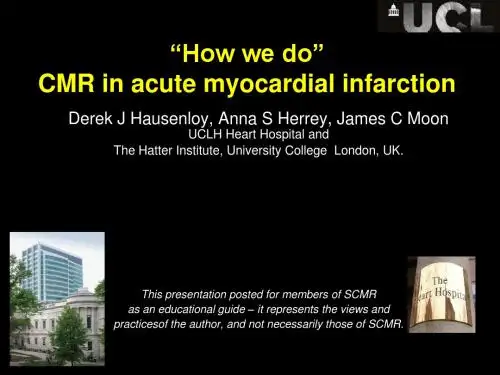
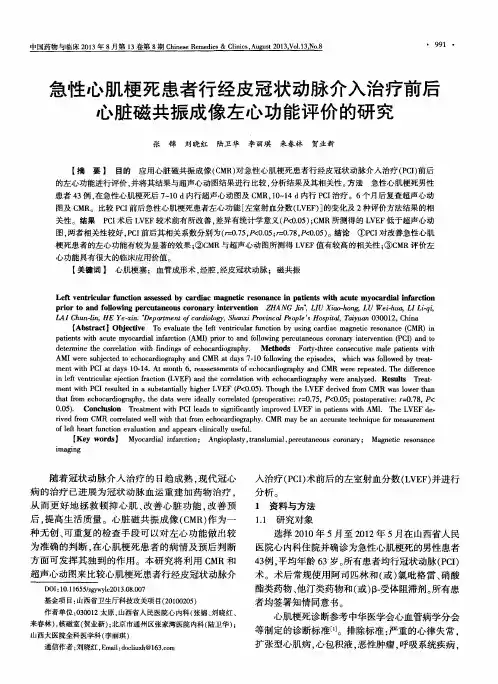
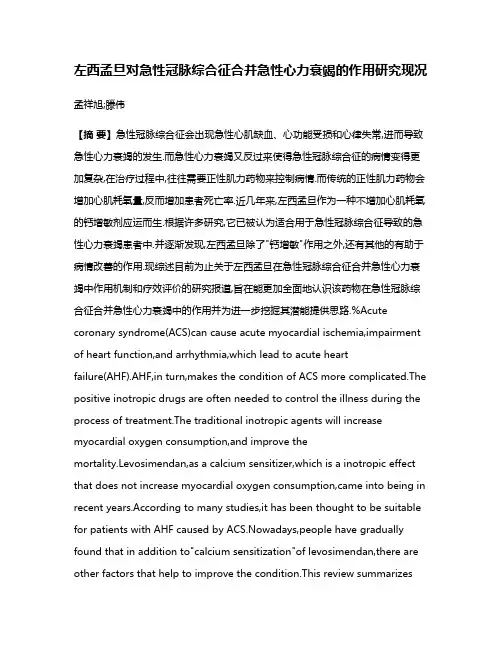
左西孟旦对急性冠脉综合征合并急性心力衰竭的作用研究现况孟祥旭;滕伟【摘要】急性冠脉综合征会出现急性心肌缺血、心功能受损和心律失常,进而导致急性心力衰竭的发生.而急性心力衰竭又反过来使得急性冠脉综合征的病情变得更加复杂,在治疗过程中,往往需要正性肌力药物来控制病情.而传统的正性肌力药物会增加心肌耗氧量,反而增加患者死亡率.近几年来,左西孟旦作为一种不增加心肌耗氧的钙增敏剂应运而生.根据许多研究,它已被认为适合用于急性冠脉综合征导致的急性心力衰竭患者中.并逐渐发现,左西孟旦除了"钙增敏"作用之外,还有其他的有助于病情改善的作用.现综述目前为止关于左西孟旦在急性冠脉综合征合并急性心力衰竭中作用机制和疗效评价的研究报道,旨在能更加全面地认识该药物在急性冠脉综合征合并急性心力衰竭中的作用并为进一步挖掘其潜能提供思路.%Acute coronary syndrome(ACS)can cause acute myocardial ischemia,impairment of heart function,and arrhythmia,which lead to acute heartfailure(AHF).AHF,in turn,makes the condition of ACS more complicated.The positive inotropic drugs are often needed to control the illness during the process of treatment.The traditional inotropic agents will increase myocardial oxygen consumption,and improve themortality.Levosimendan,as a calcium sensitizer,which is a inotropic effect that does not increase myocardial oxygen consumption,came into being in recent years.According to many studies,it has been thought to be suitable for patients with AHF caused by ACS.Nowadays,people have gradually found that in addition to"calcium sensitization"of levosimendan,there are other factors that help to improve the condition.This review summarizesthe reports so far on the mechanism and efficacy of levosimendan in the treatment of ACS complicated with AHF,so that people can fully understand the role of levosimendan in ACS complicated with AHF and provide ideas for further exploring of its potential.【期刊名称】《心血管病学进展》【年(卷),期】2018(039)003【总页数】4页(P394-397)【关键词】左西孟旦;急性冠脉综合征;急性心力衰竭【作者】孟祥旭;滕伟【作者单位】河南大学第一附属医院心血管内科,河南开封475000;河南大学第一附属医院心血管内科,河南开封475000【正文语种】中文【中图分类】R541.4急性冠脉综合征是导致急性心力衰竭最常见的原因之一。
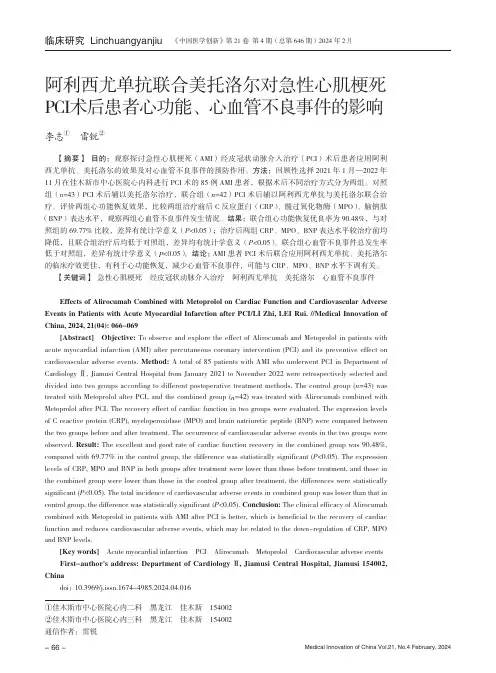
阿利西尤单抗联合美托洛尔对急性心肌梗死PCI术后患者心功能、心血管不良事件的影响李志① 雷锐② 【摘要】 目的:观察探讨急性心肌梗死(AMI)经皮冠状动脉介入治疗(PCI)术后患者应用阿利西尤单抗、美托洛尔的效果及对心血管不良事件的预防作用。
方法:回顾性选择2021年1月—2022年11月在佳木斯市中心医院心内科进行PCI术的85例AMI患者,根据术后不同治疗方式分为两组。
对照组(n=43)PCI术后辅以美托洛尔治疗,联合组(n=42)PCI术后辅以阿利西尤单抗与美托洛尔联合治疗。
评价两组心功能恢复效果,比较两组治疗前后C反应蛋白(CRP)、髓过氧化物酶(MPO)、脑钠肽(BNP)表达水平,观察两组心血管不良事件发生情况。
结果:联合组心功能恢复优良率为90.48%,与对照组的69.77%比较,差异有统计学意义(P<0.05);治疗后两组CRP、MPO、BNP表达水平较治疗前均降低,且联合组治疗后均低于对照组,差异均有统计学意义(P<0.05)。
联合组心血管不良事件总发生率低于对照组,差异有统计学意义(P<0.05)。
结论:AMI患者PCI术后联合应用阿利西尤单抗、美托洛尔的临床疗效更佳,有利于心功能恢复,减少心血管不良事件,可能与CRP、MPO、BNP水平下调有关。
【关键词】 急性心肌梗死 经皮冠状动脉介入治疗 阿利西尤单抗 美托洛尔 心血管不良事件 Effects of Alirocumab Combined with Metoprolol on Cardiac Function and Cardiovascular Adverse Events in Patients with Acute Myocardial Infarction after PCI/LI Zhi, LEI Rui. //Medical Innovation of China, 2024, 21(04): 066-069 [Abstract] Objective: To observe and explore the effect of Alirocumab and Metoprolol in patients with acute myocardial infarction (AMI) after percutaneous coronary intervention (PCI) and its preventive effect on cardiovascular adverse events. Method: A total of 85 patients with AMI who underwent PCI in Department of Cardiology Ⅱ, Jiamusi Central Hospital from January 2021 to November 2022 were retrospectively selected and divided into two groups according to different postoperative treatment methods. The control group (n=43) was treated with Metoprolol after PCI, and the combined group (n=42) was treated with Alirocumab combined with Metoprolol after PCI. The recovery effect of cardiac function in two groups were evaluated. The expression levels of C reactive protein (CRP), myeloperoxidase (MPO) and brain natriuretic peptide (BNP) were compared between the two groups before and after treatment. The occurrence of cardiovascular adverse events in the two groups were observed. Result: The excellent and good rate of cardiac function recovery in the combined group was 90.48%, compared with 69.77% in the control group, the difference was statistically significant (P<0.05). The expression levels of CRP, MPO and BNP in both groups after treatment were lower than those before treatment, and those in the combined group were lower than those in the control group after treatment, the differences were statistically significant (P<0.05). The total incidence of cardiovascular adverse events in combined group was lower than that in control group, the difference was statistically significant (P<0.05). Conclusion: The clinical efficacy of Alirocumab combined with Metoprolol in patients with AMI after PCI is better, which is beneficial to the recovery of cardiac function and reduces cardiovascular adverse events, which may be related to the down-regulation of CRP, MPO and BNP levels. [Key words] Acute myocardial infarction PCI Alirocumab Metoprolol Cardiovascular adverse events First-author's address: Department of Cardiology Ⅱ, Jiamusi Central Hospital, Jiamusi 154002, China doi:10.3969/j.issn.1674-4985.2024.04.016①佳木斯市中心医院心内二科 黑龙江 佳木斯 154002②佳木斯市中心医院心内三科 黑龙江 佳木斯 154002通信作者:雷锐- 66 - 急性心肌梗死(AMI)是血供因冠脉病变急剧减少,以致心肌细胞不能及时得到血氧支持而逐渐凋亡、坏死,导致心排血量降低,影响心脏舒缩功能,难以满足组织代谢需要,进而阻碍机体循环的一种综合征[1]。
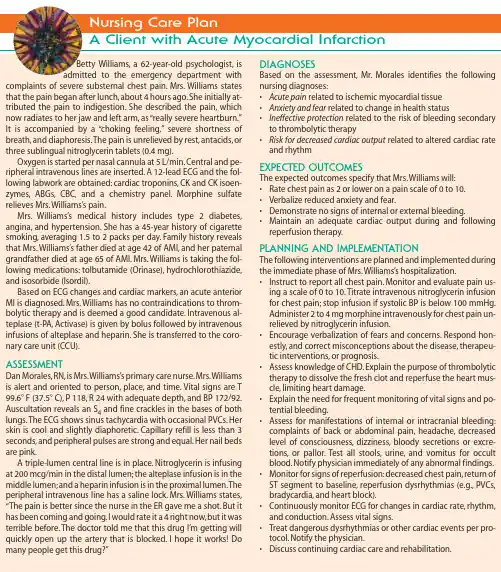
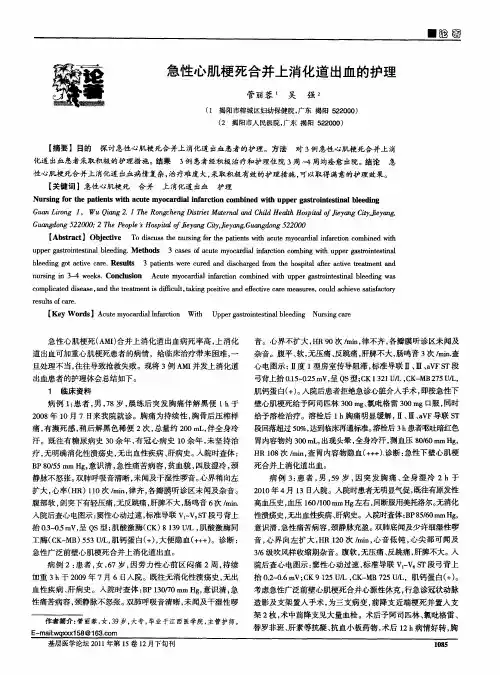
[9]ZHOU D,YAN M Q,CHENG Q,et al.Prevalence and prognosis ofleft ventricular diastolic dysfunction in community hypertensionpatients[J].BMC Cardiovascular Disorders,2022,22(1):265. [10]JENAB Y,HEDAYAT B,KARIMI A,et al.Effects of opium use onone-year major adverse cardiovascular events(MACE)in thepatients with ST-segment elevation MI undergoing primary PCI:apropensity score matched-machine learning based study[J].BMC Complementary Medicine and Therapies,2023,23(1):16. [11]MASOUDKABIR F,YAVARI N,PASHANG,et al.Effect ofpersistent opium consumption after surgery on the long-term outcomes of surgical revascularisation[J].European Journal ofPreventive Cardiology,2020,27(18):1996-2003.[12]何远利,安祯祥,杨蕊琳,等.心衰宁合剂对慢性心力衰竭大鼠心肌AMPK和PPARα的影响[J].中药新药与临床药理,2020,31(3):287-293.[13]丁应勇.中西医结合心竭宁方治疗冠心病慢性心衰临床价值研究[J].饮食保健,2020,7(11):110-111.[14]陈可斌,史超,寻增艳,等.心电图ST段压低㊁QTc㊁QTd及投影间夹角有助于判断慢性心力衰竭患者心脏同步化治疗的预后[J].内科急危重症杂志,2022,28(4):301-304.[15]范梦丽,孟红社.2型糖尿病合并慢性心力衰竭患者发生主要心血管不良事件的影响因素[J].河南医学研究,2021,30(4):628-630.[16]哈斯,莎其尔,于立鹏,等.老年心力衰竭患者BNP㊁LVEDD㊁LVEF水平与心脏功能的关系[J].现代生物医学进展,2021,21(21):4113-4117.[17]杨东,骆昌云,刘川,等.急性心力衰竭合并房颤患者sST2㊁BNP㊁AngⅡ的表达及意义[J].解放军医药杂志,2022,34(2):79-82. [18]BACKHAUS S J,KOWALLICK J T,STIERMAIER T,et al.Culpritvessel-related myocardial mechanics and prognostic implicationsfollowing acute myocardial infarction[J].Clinical Research inCardiology,2020,109(3):339-349.[19]TOVAR FORERO M N,ZANCHIN T,MASDJEDI K,et al.Incidenceand predictors of outcomes after a first definite coronary stentthrombosis[J].EuroIntervention,2020,16(4):e344-e350. [20]韦荣文,王惠香,黄慧琨.心脏超声对高血压左室肥厚伴左心力衰竭的临床诊断价值[J].影像研究与医学应用,2021,5(20):62-63.(收稿日期:2023-03-12)(本文编辑郭怀印)外周血应激性血糖升高比值联合前白蛋白对AMI并发急性左心衰竭病人预后不良的预测价值米黑热古丽㊃艾尼瓦尔,李超摘要目的:探讨外周血应激性血糖升高比值(SHR)㊁前白蛋白(PA)对急性心肌梗死(AMI)并发急性左心衰竭(ALHF)病人预后不良的预测价值㊂方法:选取2019年5月 2021年4月北京儿童医院新疆医院收治的317例AMI病人作为研究对象,根据有无并发急性左心衰竭将其分为急性左心衰竭组(113例)和非急性左心衰竭组(204例)㊂采集病人外周血样,检测入院即刻血糖水平㊁空腹糖化血红蛋白水平和PA水平,计算SHR㊂跟踪随访急性左心衰竭组病人治疗后12个月内的生存情况,根据病人有无发生心源性死亡将其分为预后不良组和预后良好组,分析AMI并发急性左心衰竭病人预后不良的影响因素,另绘制受试者工作特征(ROC)曲线分析外周血SHR和PA对AMI并发急性左心衰竭病人预后不良的预测价值㊂结果:急性左心衰竭组外周血SHR高于非急性左心衰竭组(P<0.05),外周血PA水平低于非急性左心衰竭组(P<0.05);急性左心衰竭组病人随访12个月内预后不良发生率为35.40%,预后不良组年龄㊁SHR高于预后良好组(P<0.05),外周血PA水平㊁左室射血分数及再灌注㊁β受体阻断剂㊁他汀类药物治疗占比均低于预后良好组(P<0.05)㊂Logistic回归分析结果显示,年龄㊁外周血SHR高及左室射血分数㊁外周血PA水平低均是AMI并发急性左心衰竭病人预后不良的危险因素(P<0.05),再灌注㊁β受体阻断剂㊁他汀类药物治疗是AMI并发急性左心衰竭病人预后不良的保护因素(P<0.05);外周血SHR㊁PA水平单项及二者联合预测AMI并发急性左心衰竭病人预后不良的敏感度分别为75.00%㊁67.50%㊁92.50%,特异度分别为89.04%㊁93.15%㊁86.30%,曲线下面积(AUC)分别为0.752,0.798,0.913,二者联合预测的敏感度和AUC均高于单项预测(P<0.05)㊂结论:AMI并发急性左心衰竭病人外周血SHR明显升高,PA水平明显降低,二者均与病人预后不良有关,对预后具有预测价值,但联合预测更有助于临床评估病人预后情况㊂关键词急性心肌梗死;急性左心衰竭;应激性血糖升高比值;前白蛋白;预后d o i:10.12102/j.i s s n.1672-1349.2024.06.025作者单位北京儿童医院新疆医院/新疆维吾尔自治区儿童医院(乌鲁木齐830054),E-mail:****************引用信息米黑热古丽㊃艾尼瓦尔,李超.外周血应激性血糖升高比值联合前白蛋白对AMI并发急性左心衰竭病人预后不良的预测价值[J].中西医结合心脑血管病杂志,2024,22(6):1094-1098.急性心力衰竭是急性心肌梗死(AMI)的严重并发症,其中以急性左心衰竭(ALHF)最为常见,不仅增加AMI病人治疗难度和费用,也明显增加了病人的病死率[1]㊂调查显示,AMI合并急性左心衰竭病人1年㊁5年病死率分别高达37%㊁62%[2]㊂因此,探讨早期预测AMI合并急性左心衰竭病人预后的指标以指导临床干预,对改善病人预后具有重要意义㊂既往研究报道,在机体遭受AMI㊁急性左心衰竭等严重疾病时会出现应激性高血糖,血糖适度升高可维持梗死心肌能量供给,减轻损伤,但过度升高会激活氧化应激和免疫应答,加重微循环障碍和心肌损伤,单一检测血糖或糖化血红蛋白容易忽略基础血糖水平对应激性血糖改变的影响[3]㊂应激性血糖升高比值(SHR)是近年来提出的评估应激性血糖水平相对变化的新参数,且国内外研究均发现SHR与AMI病人并发严重心力衰竭㊁心源性休克和死亡率相关[4-5]㊂前白蛋白(PA)是肝脏在机体严重感染㊁创伤㊁AMI等急性期合成的蛋白,可反映机体损伤程度和营养状况,Wang等[6]研究表明,较低的PA与冠心病严重程度和心脏不良事件发生有关㊂本研究观察AMI合并急性左心衰竭病人SHR和PA 变化,探讨SHR和PA对AMI并发急性左心衰竭病人预后不良的预测价值㊂1资料与方法1.1一般资料选取2019年5月 2021年4月我院收治的317例AMI病人作为研究对象㊂纳入标准:符合AMI诊断标准[7],发病到入院治疗不超过24h;年龄18~80岁;签署知情同意书者㊂排除标准:严重肝㊁肾㊁肺等功能不全者;近1个月有严重创伤㊁感染或手术史;既往有急性左心衰竭史;合并心肌炎㊁肥厚型心肌病㊁瓣膜病㊁主动脉夹层等;先天性心脏病病人;恶性肿瘤病人;合并白血病㊁血友病等血液系统疾病;妊娠期或哺乳期女性病人;神经器质性病变及精神疾病病人㊂急性左心衰竭诊断标准:1)既往有心脏病史或心力衰竭史;2)突发呼吸困难㊁端坐呼吸㊁发绀㊁咳粉红泡沫痰;3)听诊两肺湿啰音(或伴哮鸣音)㊁心率快㊁闻及奔马律,胸部X 线示肺淤血㊁肺水肿;4)心脏生物学标志物血浆B型钠尿肽㊁N末端脑钠肽前体㊁肌钙蛋白等明显升高[8]㊂根据AMI病人有无并发急性左心衰竭将其分为两组,急性左心衰竭组113例,其中,男60例,女53例;年龄53~77(66.93ʃ6.27)岁;体质指数(BMI)20~29(24.89ʃ2.56)kg/m2㊂非急性左心衰竭组204例,其中,男106例,女98例;年龄51~76(66.47ʃ6.59)岁;BMI20~ 29(25.02ʃ2.74)kg/m2㊂两组性别㊁年龄㊁BMI比较差异均无统计学意义(P>0.05)㊂本研究经医院伦理委员会批准(伦理批号:201903-002)㊂1.2方法1.2.1SHR检测于病人入院后即刻采集肘静脉血,应用全自动生化分析仪测定入院即刻血糖水平,另于入院后次日清晨采集病人空腹静脉血样,应用全自动糖化血红蛋白分析仪检测糖化血红蛋白(HbA1c)水平,应用全自动生化分析仪检测血清PA水平㊂计算SHR,SHR=入院即刻血糖水平/(1.59ˑHbA1c-2.59)㊂1.2.2资料收集及随访收集病人的性别㊁年龄㊁BMI㊁心率㊁血压㊁既往病史(心肌梗死㊁慢性心力衰竭)㊁合并疾病(糖尿病㊁高血压㊁高脂血症)㊁实验室检查情况(外周血SHR㊁外周血PA㊁血红蛋白㊁血肌酐㊁血钠㊁血钾㊁N末端脑钠肽前体㊁肌酸激酶同工酶)㊁心肌梗死类型㊁左室射血分数㊁Killip心功能分级㊁治疗情况[再灌注治疗(溶栓或PCI)㊁血管紧张素转化酶抑制剂(ACEI)/血管紧张素Ⅱ拮抗剂(ARB)㊁β受体阻断剂㊁他汀类药物㊁利尿剂㊁抗血小板药物]等㊂对急性左心衰竭组病人进行跟踪随访,病人出院后1㊁3㊁6㊁12个月来院复诊,同时每月电话随访病人预后情况㊂根据随访12个月内病人有无发生心源性死亡将其分为预后不良组和预后良好组㊂1.3观察指标比较急性左心衰竭组和非急性左心衰竭组外周血SHR及PA水平;统计急性左心衰竭组预后情况,比较预后良好组和预后不良组临床资料;分析AMI并发急性左心衰竭病人预后不良的影响因素,并分析外周血SHR及PA水平对AMI并发急性左心衰竭病人预后不良的预测价值㊂1.4统计学处理采用SPSS26.0软件进行统计分析㊂对定量资料均行正态性检验,符合正态分布以均数ʃ标准差(xʃs)表示,两组间比较采用独立样本t检验;偏态分布以中位数及四分位数[M(P25,P75)]表示,采用Mann-Whitney U检验㊂定性资料以例数或百分率表示,采用χ2检验,若任一理论频数>1且<5时需对检验进行校正;采用Logistic回归分析探讨AMI并发急性左心衰竭病人预后不良的影响因素,记录比值比(OR)和95%置信区间(95%CI);采用受试者工作特征曲线(ROC)分析外周血SHR及PA水平对AMI并发急性左心衰竭病人预后不良的预测价值,记录截断值㊁敏感度㊁特异度㊁曲线下面积(AUC)和95%CI㊂以P<0.05为差异有统计学意义㊂2结果2.1急性左心衰竭组和非急性左心衰竭组外周血SHR及PA水平比较急性左心衰竭组外周血SHR高于非急性左心衰竭组(P<0.05),外周血PA水平低于非急性左心衰竭组(P<0.05)㊂详见表1㊂表1急性左心衰竭组和非急性左心衰竭组外周血SHR及PA水平比较[M(P25,P75)]组别例数SHR PA(g/L)急性左心衰竭组113 1.19(0.87,1.43)0.19(0.15,0.21)非急性左心衰竭组204 1.03(0.75,1.33)0.23(0.18,0.30) U值907.500618.000P0.001<0.0012.2预后良好组和预后不良组临床资料比较113例急性左心衰竭病人随访12个月内有40例发生心源性死亡,预后不良发生率为35.40%(40/113)㊂预后不良组年龄㊁SHR高于预后良好组(P<0.05),外周血PA水平㊁左室射血分数及再灌注㊁β受体阻断剂㊁他汀类药物治疗占比均低于预后良好组(P<0.05)㊂详见表2㊂表2预后良好组和预后不良组临床资料比较项目预后不良组(n=40)预后良好组(n=73)统计值P 男性[例(%)]19(47.50)41(56.16)χ2=0.7790.377年龄(岁)70.06ʃ5.2865.21ʃ6.44t=4.070<0.001 BMI(kg/m2)24.77ʃ2.4624.96ʃ2.28t=-0.4120.681心率(次/min)91.84ʃ20.6786.57ʃ18.29t=1.3980.165收缩压(mmHg)135.36ʃ28.13128.44ʃ27.52t=1.2680.207舒张压(mmHg)76.54ʃ15.3875.94ʃ16.22t=0.1910.849既往病史[例(%)]心肌梗死13(32.50)20(27.40)χ2=0.3250.568慢性心力衰竭17(42.50)24(32.88)χ2=1.0350.309合并疾病[例(%)]糖尿病16(40.00)31(42.47)χ2=0.0650.799高血压29(72.50)48(65.75)χ2=0.5420.462高脂血症[例(%)]5(12.50)10(13.70)χ2=0.0120.912 SHR 1.45(1.28,1.66) 1.08(0.84,1.27)U=723.000<0.001 PA(g/L)0.14(0.12,0.18)0.20(0.18,0.22)U=590.000<0.001血红蛋白(g/L)118.94ʃ11.53123.61ʃ13.89t=-1.8110.073血肌酐(μmol/L)103.15(70.28,128.74)95.88(64.57,120.13)U=1304.5000.344血钠(mmol/L)137.11ʃ5.48137.79ʃ5.86t=-0.6030.548血钾(mmol/L) 4.13ʃ0.75 4.05ʃ0.66t=0.5870.558 N末端脑钠肽前体(ng/L)6071(2935,16829)4512(2406,10764)U=1127.5000.219肌酸激酶同工酶(U/L)236.57ʃ38.62224.13ʃ35.39t=1.7300.086 ST段抬高型心肌梗死[例(%)]14(35.00)28(38.36)χ2=0.1250.724左室射血分数(%)44.21ʃ12.8948.76ʃ10.24t=-2.0570.042 Killip心功能分级[例(%)] Ⅱ级13(32.50)38(52.05)Ⅲ级17(42.50)22(30.14)U=3.9900.134Ⅳ级10(25.00)13(17.81)治疗情况[例(%)]再灌注14(35.00)49(67.12)χ2=10.8090.001 ACEI/ARB10(25.00)28(38.36)χ2=2.0650.151β受体阻断剂26(65.00)61(83.56)χ2=5.0260.025他汀类药物28(70.00)69(94.52)χ2=12.783<0.001利尿剂32(80.00)60(82.19)χ2=0.0820.775抗血小板药物37(92.50)70(95.89)χ2=0.5910.4422.3AMI并发急性左心衰竭病人预后不良影响因素分析将AMI并发急性左心衰竭病人预后情况作为因变量(预后良好=0,预后不良=1),将上述预后良好组和预后不良组临床资料比较P<0.10的项目作为自变量[年龄(实测值)㊁外周血SHR(实测值)㊁PA水平(实测值)㊁血红蛋白水平(实测值)㊁肌酸激酶同工酶(实测值)㊁左室射血分数(实测值)㊁再灌注(有=0,无=1)㊁β受体阻断剂(有=0,无=1)㊁他汀类药物治疗(有=0,无=1)],进行Logistic回归分析,结果显示,年龄大㊁外周血SHR高及左室射血分数㊁外周血PA水平降低均是AMI并发急性左心衰竭病人预后不良的危险因素(P <0.05),再灌注㊁β受体阻断剂㊁他汀类药物治疗是AMI 并发急性左心衰竭病人预后不良的保护因素(P <0.05)㊂详见表3㊂表3 AMI 并发急性左心衰竭病人预后不良的影响因素分析变量回归系数标准误Wald χ2值P OR 值95%CI 年龄0.6530.2089.8560.002 1.921[1.278,2.888]左室射血分数0.8950.3168.0220.005 2.447[1.317,4.546]外周血SHR 1.0770.29113.698<0.001 2.936[1.660,5.194]外周血PA 水平 1.1640.32412.907<0.001 3.203[1.697,6.044]再灌注-0.6290.2178.4020.0040.533[0.348,0.816]β受体阻断剂治疗-0.3720.158 5.5430.0180.689[0.506,0.939]他汀类药物治疗-0.5260.1947.3510.0060.591[0.404,0.864]常数项-7.0241.44723.555<0.0012.4 外周血SHR 及PA 水平对AMI 并发急性左心衰竭病人预后不良的预测价值外周血SHR ㊁PA 水平联合预测AMI 并发急性左心衰竭病人预后不良的敏感度均高于单项指标预测(χ2=4.501,P =0.034;χ2=7.813,P =0.005);AUC 均高于单项指标预测(Z =2.727,P =0.006;Z =2.050,P =0.040);特异度与单项指标预测对比差异均无统计学意义(P >0.05)㊂详见表4㊁图1㊂表4 外周血SHR 及PA 水平对AMI 并发急性左心衰竭病人预后不良的预测价值项目截断值敏感度(%)特异度(%)AUC 95%CI SHR 1.34 75.0089.040.752[0.662,0.829]PA 0.16g/L67.5093.150.798[0.712,0.868]二者联合92.5086.300.913[0.845,0.958]图1 外周血SHR 、PA 单项及联合预测AMI并发急性左心衰竭病人预后不良的ROC 曲线3 讨 论急性左心衰竭是AMI 的并发症之一,具有较高的致残率㊁致死率㊂随着医疗水平的发展,临床在治疗AMI 并发急性左心衰竭病人效果方面也取得了很大进步,但仍有较高的再住院率和病死率[9]㊂本研究通过对AMI 并发急性左心衰竭病人进行随访,发现治疗后12个月预后不良发生率高达35.40%,由此可见预测AMI 并发急性左心衰竭病人预后不良风险对指导临床早期个体化㊁循证治疗具有重要意义㊂SHR 反映应激状态下血糖变化情况,机体在应激状态下会产生儿茶酚胺㊁肾上腺素㊁胰高血糖素等,导致胰岛素抵抗和糖异生,进而使血糖迅速升高[10]㊂有研究报道,血糖升高能够反映疾病严重程度和应激程度,血糖升高越显著,提示疾病越严重,应激反应越剧烈[11]㊂本研究发现,急性左心衰竭组外周血SHR 高于非急性左心衰竭组,说明AMI 并发急性左心衰竭病人SHR 高于未并发急性左心衰竭病人,可能由于AMI 病人在并发急性左心衰竭后应激反应进一步加剧,导致血糖显著升高,SHR 较高㊂应激状态下血糖升高虽对机体具有一定的保护作用,但血糖过度升高会上调富含线粒体相关内质网膜蛋白表达,破坏钙离子平衡,激活心肌细胞内质网应激㊁线粒体氧化应激,促进心肌细胞死亡[12];Thakur 等[13]研究发现,在高血糖状态下,心肌细胞暴露24h 后心肌标志物肌钙蛋白及CXC 趋化因子㊁热休克蛋白㊁Toll 样受体等炎症相关介质上调,心肌细胞受损,心脏收缩功能也发生障碍㊂以上研究均提示应激状态下高血糖可能会对AMI 并发急性左心衰竭病人预后造成影响㊂故本研究进一步比较AMI 并发急性左心衰竭病人中不同预后病人SHR ,发现预后不良组SHR 高于预后良好组,且经Logistic 回归分析证实SHR 较高是病人预后不良的危险因素㊂吴伏鹏等[14]研究也发现,急性心力衰竭病人中SHR高水平组死亡率高于低水平组,SHR水平升高是此类病人死亡的独立危险因素㊂PA是一种急性期负性蛋白,半衰期短,相比清蛋白更能准确评估机体营养状态和炎症状态,且能在一定程度上反映损伤程度㊂既往研究发现,在AMI病人中PA水平随心功能分级升高而降低,且并发心力衰竭病人PA水平低于未并发病人[15]㊂本研究也发现急性左心衰竭组外周血PA水平低于非急性左心衰竭组,与上述研究报道一致,提示PA水平降低可能与AMI病人病情程度有关㊂本研究还发现AMI并发急性左心衰竭病人中预后不良组PA水平低于预后良好组,且经Logistic回归分析证实PA水平较低是病人预后不良的危险因素㊂炎症反应在AMI和急性左心衰竭发病机制中起重要作用,急性期病情加重,炎症反应剧烈,使PA合成受抑制,水平降低,同时AMI并发急性左心衰竭处于应激状态,能量代谢增加,且病情严重㊁病程长,机体消耗巨大,常导致营养不良,PA水平降低,而营养不良又会使机体免疫力下降,加重感染,恶化心功能,导致预后不良[16]㊂Akashi等[17]研究也发现,急性心力衰竭病人入院时PA水平较低与较高的死亡率相关,能够有效预测病人全因性死亡㊂本研究进一步绘制ROC曲线分析外周血SHR㊁PA水平单项及联合预测AMI并发急性左心衰竭病人预后不良的价值,发现联合预测的敏感度和AUC均高于单项预测,特异度与单项预测相近,提示外周血SHR㊁PA水平联合检测更有助于临床评估AMI并发急性左心衰竭病人预后不良的风险,以便早期对此类病人进行危险分层,给予个体化干预以改善预后㊂此外,本研究还发现年龄大㊁左室射血分数低均也是AMI并发急性左心衰竭病人预后不良的危险因素,再灌注㊁β受体阻断剂㊁他汀类药物治疗是预后不良的保护因素,与既往研究报道[18-19]一致㊂综上所述,AMI并发急性左心衰竭病人SHR升高,PA水平降低,均是AMI并发急性左心衰竭病人预后不良的危险因素,且对预后不良具有预测价值,二者联合预测应用价值更高㊂但本研究尚有不足:如单中心研究样本选取相对较为局限㊁样本量较小;对病人发生应激性血糖改变机制尚未完全清楚,需进一步深入探讨;未具体分析SHR对伴或不伴糖尿病病人预后的影响㊂参考文献:[1]KAMON D,SUGAWARA Y,SOEDA T,et al.Predominant subtypeof heart failure after acute myocardial infarction is heart failurewith non-reduced ejection fraction[J].ESC Heart Failure,2021,8(1):317-325.[2]李杨,孙筱璐,秦俭,等.急诊科急性心肌梗死后并发急性心力衰竭患者远期预后及其影响因素研究[J].中国临床医生杂志,2021,49(4):408-414.[3]STALIKAS N,PAPAZOGLOU A S,KARAGIANNIDIS E,et al.Association of stress induced hyperglycemia with angiographicfindings and clinical outcomes in patients with ST-elevationmyocardial infarction[J].Cardiovascular Diabetology,2022,21(1):140.[4]汤莉莹,白玉芝,王晶,等.应激性高血糖及氧化应激产物水平对急性心肌梗死患者预后的评估价值[J].中国急救医学,2019,39(1):57-60.[5]RAJPUROHIT A,SEJOO B,BHATI R,et al.Association of stresshyperglycemia and adverse cardiac events in acute myocardialinfarction--a cohort study[J].Cardiovasc Hematol Disord DrugTargets,2021,21(4):260-265.[6]WANG W,WANG C S,REN D,et al.Low serum prealbumin levelson admission can independently predict in-hospital adversecardiac events in patients with acute coronary syndrome[J].Medicine,2018,97(30):e11740.[7]中华医学会心血管病学分会,中华心血管病杂志编辑委员会.急性ST段抬高型心肌梗死诊断和治疗指南[J].中华心血管病杂志,2010,38(8):675-690.[8]中国医师协会急诊医师分会,中国心胸血管麻醉学会急救与复苏分会.中国急性心力衰竭急诊临床实践指南(2017)[J].中华急诊医学杂志,2017,26(12):1347-1357.[9]DHARMA S,DAKOTA I,ANDRIANTORO H,et al.Association ofgender with clinical outcomes of patients with acute ST-segmentelevation myocardial infarction presenting with acute heart failure[J].Coronary Artery Disease,2021,32(1):17-24.[10]CHEUNG N W,CARMEN WONG K Y C,KOVOOR P,et al.Stresshyperglycemia:a prospective study examining the relationshipbetween glucose,cortisol and diabetes in myocardial infarction[J].Journal of Diabetes and Its Complications,2019,33(4):329-334.[11]SIGIRCI S,YILDIZ S S,KESKIN K,et al.The predictive value ofstress hyperglycemia on thrombus burden in nondiabeticpatients with ST-segment elevation myocardial infarction[J].Blood Coagulation&Fibrinolysis,2019,30(6):270-276. [12]WU L D,LIU Y,LI F,et al.Glucose fluctuation promotescardiomyocyte apoptosis by triggering endoplasmic reticulum(ER)stress signaling pathway in vivo and in vitro[J].Bioengineered,2022,13(5):13739-13751.[13]THAKUR V,ALCOREZA N,CAZARES J,et al.Changes in stress-mediated markers in a human cardiomyocyte cell line underhyperglycemia[J].International Journal of Molecular Sciences,2021,22(19):10802.[14]吴伏鹏,朱晓光,李梅芳,等.应激性血糖升高比值对急性心力衰竭患者预后的评估价值[J].中华急诊医学杂志,2021,30(3):318-322.[15]凌杰兵,马斌.血清超敏C-反应蛋白与前白蛋白比值对急性心肌梗死患者并发心力衰竭的预测价值研究[J].临床误诊误治,2018,31(1):82-85.[16]宋仁杏,高倩萍.血浆前白蛋白水平对心力衰竭严重程度及预后的影响[J].心血管病学进展,2018,39(3):392-394.[17]AKASHI M,MINAMI Y,HARUKI S,et al.Prognostic implications ofprealbumin level on admission in patients with acute heart failurereferred to a cardiac intensive care unit[J].Journal ofCardiology,2019,73(2):114-119.[18]苗博,李延鑫,吴静,等.静息心率与行PCI治疗的急性心肌梗死合并心力衰竭患者远期预后的关系[J].现代医学,2021,49(5):494-500.[19]DESTA L,KHEDRI M,JERNBERG T,et al.Adherence to beta-blockers and long-term risk of heart failure and mortality after amyocardial infarction[J].ESC Heart Fail,2021,8(1):344-355.(收稿日期:2022-09-28)(本文编辑郭怀印)。
糖尿病合并心肌梗死的分析肖泽勇【摘要】目的分析糖尿病(diabetes mellitus,DM)合并心肌梗死患者(acute myocardial infarction,AMI)的冠脉病变及临床特点.方法回顾性分析217例心肌梗死患者的临床资料,根据是否合并糖尿病,分为糖尿病组(DM组)和非糖尿病组(NDM组),对比分析其冠脉病变特点、临床症状和梗死部位.结果DM组血糖(BG)、总胆固醇(TC)、三酰甘油(TG)水平均高于NDM组(P<0.05或P<0.01);DM组患者冠状动脉双支、三支病变和中度、重度狭窄程度发生率明湿高于NDM组(P<0.05或P<0.01);DM组患者高血压、非典型胸痛、心律失常、心力衰竭、心源性休克和肺部感染发生率均明显高于NDM组(P<0.05或P<0.01);DM组心肌多部位梗死和无Q波型发生率与NDM组比较差异有统计学意义(P <0.05或P<0.01).结论糖尿病合并心肌梗死患者冠脉病变和临床症状比非糖尿病心肌梗死患者严重.%Objective To analyze the characteristics of coronary lesions and clinical symptoms of patients with diabetes mellitus (DM) combined with acute myocardial infarction (AMI). Methods Clinical data of 217 cases of myocardial infarction patients were analyzed retrospectively, and all patients were divided into the diabetic mellitus group (DM group) andnon-diabetic mellitus group (NDM group) according to whether combined with mellitus diabetes or not. The coronary lesion characteristics, clinical symptoms and infarction area of the two groups were comparative analyzed. Results Blood glucose (BG), total cholesterol (TC), triglyceride (TG) levels of DM group were all higher than those of the NDM group (P < 0.05 or P < 0.01); compared with the NDM group patients, incidence of double-vessels, three-vessels lesion, moderate and severe degree of coronary artery stenosis in the DM group were significantly higher (P < 0.05 or P < 0.01); hypertension, atypical chest pain, arrhythmia, heart failure, cardiogenic shock and pulmonary infection of patients in the DM group were significantly higher than the NDM group (P < 0.05 or P < 0.01); compared with the NDM group, incidence of myocardial multi-site infarction and non-Q wave in the DM group had significantly statistical differences (P < 0.05 or P < 0.01). Conclusion Coronary lesions and clinical symptoms of mellitus diabetic patients combined with myocardial infarction are more serious than non-diabetic patients with myocardial infarction.【期刊名称】《中国医药导报》【年(卷),期】2012(009)018【总页数】2页(P79-80)【关键词】糖尿病;心肌梗死;冠脉病变【作者】肖泽勇【作者单位】广州医学院附属沙井医院急诊科,广东深圳518104【正文语种】中文【中图分类】R542.22糖尿病(DM)是危害人类健康的疾病之一,可引起各种慢性并发症,是冠心病的独立危险因素[1]。
New Universal Definition of Myocardial InfarctionAthanasios G. Pipilis, MDRecently, a joint ESC/ACCF/AHA/WHF Task Force published an expert consen-sus document on the universal definition of myocardial infarction [1]. The following points are extracts from this document that summarize its main features.The main reason for agreeing on a new definition of myocardial infarction derives from the development and the wide availability of very sensitive and specific serological biomarkers that are able to detect even minimal myocardial necrosis.Acute myocardial infarction is diagnosed when there is evidence of myocardial cell necrosis in the clinical setting of myocardial ischemia. In contrast to the historical World Health Organization (WHO) definition where symptoms, ECG and enzymes had equal weight for the diagnosis (the presence of any two would suffice), today bi-omarkers take precedence with imaging having also a diagnostic role. Consequently, acute myocardial infarction is diagnosed if a rise and fall of cardiac biomarkers (prefer-ably troponin) is detected together with at least one of the following: a) symptoms of ischemia, b) new ST-T changes or new left bundle branch block (LBBB), c) development of pathological Q waves and d) imaging evidence of new loss of viable myocardium or new regional wall motion abnormality.Prior myocardial infarction requires for its diagnosis any of the following criteria: a) new Q waves, b) imaging of a regional loss of viable myocardium that is thinned and fails to contract and c) pathological findings of a healed or healing myocardium.c L I N I c A L c L A s s I f I c A t I O N O f m Y O c A r D I A LI N f A r c t I O NThe clinical classification of myocardial infarction consists of 5 types:a) Type 1: Spontaneous myocardial infarction related to ischemia due to a primary coronary event (plaque erosion, rupture, fissuring, dissection)b) Type 2: Myocardial infarction secondary to ischemia due to either increased oxygen de-mand or decreased supply (spasm, embolism, anemia, arrhythmia, hypertension, hypoten-sion)c) Type 3: Sudden unexpected death (biomarkers may have not been obtained or not yet raised)d) Type 4: Myocardial infarction associated with percutaneous coronary intervention (PCI) (type 4a) and stent thrombosis (type 4b). To diagnose peri-procedural necrosis in patients with normal baseline troponin values, biomarkers should be greater than 3 times the th percentile URL (upper reference limit).e) Type 5: Myocardial infarction associated with coronary artery bypass grafting (CABG). To diagnose peri-operative necrosis biomarkers should be greater than 5 times the th per-centile URL, together with new Q waves, LBBB, graft or native artery occlusion or imaging of new loss of viable myocardium.Associate Director of Cardiology, Hygeia Hospital, AthensHOSPITAL CHRONICLES 2008, SUPPLEMENT: 52–53Address for correspondence:E-mail: athanasios.pipilis@hygeia.grNEW UNIVERSAL DEFINITION OF MYOCARDIAL INFARCTION53c A r D I A c b I O m A r K E r s , E c G & I m A G -I N GAlthough elevation of troponin is indicative of myocardial cell damage it does not indicate the mechanism. Therefore several conditions with elevated troponin do not imply overt ischemic heart disease (for example cardiac failure, renal failure, drug toxicity, sepsis, pulmonary embolism).Electrocardiographic manifestation of ischemia that may lead to myocardial infarction are ST segment elevation (with hyperacute symmetrical increased amplitude T-waves being an early finding) or ST segment depression. New ST eleva-tion requires a J point in two contiguous leads ≥0.2 mV in men and ≥0.15 mV in women for leads V2-V3 and ≥0.1 mV for the other leads. New ST depression and T wave changes requires horizontal or down-sloping depression ≥0.05 mV in two contiguous leads and/or T wave inversion ≥0.1 mV in two contiguous leads with a prominent R wave or R/S ratio >1.Imaging techniques are applied in the acute and the healing or healed phase of myocardial infarction. Rest echocardiography is the commonest method used but cannot distinguish ischemia from infarction. Radionuclide imaging, stress echocardiography and magnetic resonance imaging (MRI) can be used to identify viability of myocardial tissue.I m P L I c A t I O N sThe new definition of myocardial infarction has several epidemiological and clinical trial implications. In epidemiol-ogy, since biomarkers are able to detect smaller infarcts the incidence of non STEMI is increased while unstable angina is becoming a rarer diagnosis. Therefore, comparison of tempo-ral trends of myocardial infarction incidence in registries will be affected and historical controls may be difficult to evaluate. In clinical trials with myocardial infarction as an outcome, an attempt to quantify myocardial damage by multiples of the th percentile URL of the biomarker is encouraged so that comparisons between various severity categories of infarction can be made possible.Finally, the new definition, with more patients with limited myocardial injuries being diagnosed as myocardial infarctions may have psychological, legal, insurance and professional consequences.s U G G E s t E D r E A D I N G1. Thygesen K, Alpert JS, White HD on behalf of the ESC/ACCF/AHA/WHF Joint Task Force for the redefinition of myocardial infarction. Universal definition of myocardial infarction. Eur Heart J 2007; 28: 2525-2538 & J Am Coll Cardiol 2007;50:2173– 5.2. The Joint ESC/ACC Committee. Myocardial infarction rede-fined—a consensus document of the Joint ESC/ACC Commit-tee for the Redefinition of Myocardial Infarction. J Am Coll Cardiol 2000; 36: 5 –6 .3. Jaffe AS, Babuin L, Apple FS. Biomarkers in acute cardiac dis-ease. J Am Coll Cardiol 2006;48:1–11.4. French JK, White HD. Clinical implications of the new defini-tion of myocardial infarction. Heart 2004; 0: –106.5. Zimetbaum PJ, Josephson ME. Use of the electrocardiogram in acute myocardial infarction. N Engl J Med 2003;348: 33– 40.6. Kligfield P, Gettes LS, Bailey JJ, et al. Recommendations for the standardization and interpretation of the electrocar-diogram. Part I: the electrocardiogram and its technology. A scientific statement from the AHA Electrocardiography and Arrhythmias Committee, Council on Clinical Cardiology; the ACC Foundation; and the Heart Rhythm Society. J Am Coll Cardiol 2007;4 :110 –27.7. Korosoglou G, Labadze N, Hansen A, et al. Usefulness of real-time myocardial perfusion imaging in the evaluation of patients with first time chest pain. Am J Cardiol 2004; 4:1225–318. Wagner A, Mahrholdt H, Holly TA, et al. Contrast-enhanced MRI and routine single photon emission computed tomography (SPECT) perfusion imaging for detection of subendocardial myocardial infarcts: an imaging study. Lancet 2003;361:374 – . . Gosalia A, Haramati LB, Sheth MP, Spindola-Franco H. CT detection of acute myocardial infarction. Am J Roentgenol 2004;182: 1563–6.10. Peels C, Visser CA, Kupper AJ, Visser FC, Roos JP. Usefulness of two-dimensional echocardiography for immediate detection of myocardial ischemia in the emergency room. Am J Cardiol 1 0;65:687– 1.11. Udelson JE, Beshansky JR, Ballin DS, et al. Myocardial perfu-sion imaging for evaluation and triage of patients with suspect-ed acute cardiac ischemia: a randomized controlled trial. JAMA 2002;288: 26 3–700.12. Kavsak PA, MacRae AR, Lustig V, et al. The impact of the ESC/ACC redefinition of myocardial infarction and new sensi-tive troponin assays on the frequency of acute myocardial in-farction. Am Heart J 2006 Jul;152(1):118-25.。
急性心肌梗死PCI术后患者5 d心脏康复程序效果研究郭晓岚,卫攀,李粉娜,王珍,程苗苗,郎红娟[摘要] 目的 探讨急性心肌梗死PCI术后患者5 d康复程序的安全性和有效性。
方法选择无合并症的急性心肌梗死患者100例,随机分为对照组和观察组各50例,对照组采用1周康复程序,观察组采用自行修订5 d康复程序,比较2组患者心率、血压、心电图ST改变、左室射血分数、平均住院日、平均住院费用、心脏事件发生率、便秘、焦虑、生活质量评分、6 min步行试验距离的差异。
结果 2组均无死亡及再梗死病例,其中心律失常、心力衰竭、心绞痛发生率及心率、血压、心电图ST段变化差异无统计学意义(P>0.05);焦虑、生活质量评分第1天差异无统计学意义(P>0.05),与对照组比较,观察组出院前差异有统计学意义(P<0.05);2组便秘发生率第1天、出院前差异无统计学意义(P>0.05),第2天差异有统计学意义(P<0.05);左室射血分数、平均住院日、6 min步行距离差异有统计学意义(P<0.05)。
结论急性心肌梗死PCI术后患者5 d康复程序安全、可行,能促进患者心功能快速恢复,提高运动耐力和自理能力,缩短住院时间,降低便秘、焦虑发生率,提高生活质量。
[关键词]急性心肌梗死;PCI术;5 d康复程序;效果研究[中图分类号]R473.5 [文献标识码] A [文章编号] 2095-3402(2021)01-054-05DOI:10.3969/j.issn.2095-3402.2021.01.016Effect of 5 d cardiac rehabilitation program on patients with acute myocardial infarction after PCI GUO Xiaolan*, WEI Pan, LI Fenna, WANG Zhen, CHENG Miaomiao, LANG Hongjuan.*Department of Cardiology,Tangdu Hospital ofAir Force Medical University,Xi'an 710038,ChinaCorresponding author: LANG Hongjuan,E-mail: langhj@[Abstract]Objective To explore the safety and effectiveness of the 5-day rehabilitation program for patients with acute myocardial infarction after PCI. Methods A total of 100 patients with acute myocardial infarction without comorbidities were randomly divided into the control group and the observation group with 50 cases each. The control group adopted a 1-week rehabilitation program, while the observation group underwent a self-revised 5-day rehabilitation program. Heart rate, blood pressure, ECG ST changes, left ventricular ejection fraction, average days and expenses of hospitalization, incidence of cardiac events, constipation, anxiety, quality of life scores, differences in 6-min walk test distance were compared between the two groups. Results There was no death or re-infarction in either group. There was no significant difference in the incidence of arrhythmia, heart failure, angina pectoris, heart rate, blood pressure, and ST segment changes in electrocardiograms (P>0.05), or in anxiety and quality of life scores on the first day (P>0.05). The observation group was significantly different from the control group before discharge (P<0.05). There was no difference in the incidence of constipation between the two groups on the first day or before discharge (P>0.05). The difference on the second day was statistically significant (P<0.05). There was statistically significant difference in left ventricular ejection fraction, average hospital stay, and 6-min walking distance between the two groups (P<0.05). Conclusion The 5-day rehabilitation program for patients with acute myocardial infarction after PCI is safe and feasible. It can promote rapid recovery of cardiac function, enhance exercise endurance and self-care ability, shorten hospital stay, reduce the incidence of constipation and anxiety, and improve the quality of life.[Key words] acute myocardial infarction; percutaneous coronary intervention; 5 d rehabilitation program; effect基金项目:空军军医大学唐都医院科研基金项目(2014HL0710)作者单位:710038 西安,空军军医大学唐都医院心内CCU(郭晓岚、李粉娜、王珍、程苗苗),护理部(卫攀);710032 西安,空军军医大学护理学院(郎红娟)通信作者:郎红娟,E-mail:langhj@我国心血管病发病率及病死率仍处于上升阶段,心血管病死亡率占城乡居民总死亡原因的首位,其中急性心肌梗死(acute myocardial infarction,AMI)病死率从2005 年开始呈现快速上升趋势[1]。
心血管医学英语单词心力衰竭:Heart failure 心力衰竭Congestive beart failure 充血性心力衰竭Acute left-sided heart failure 急性左心衰竭Chroinc heart failure 慢性心力衰竭Intractable heart failure 难治性心力衰竭Systolic insufficiency heart failure 收缩功能不全性心力衰竭Diastolic insufficiency heart failure 舒张功能不全性心力衰竭Congestive heart failure 充血性心力衰竭Cardiac dysfunction 心功能障碍心律失常:Arrhythmia (cardiac arrhythmia)心律失常Triggered activity 触发活动Afterdepolarization 后除极a.窦房结Sinus node recovery time SNRT 窦房结恢复时间Sinoatrial conduction time SACT 窦房传导时间Bradycardia 心动过缓Tachycardia 心动过速Sinus tachycardia 窦性心动过速Sinus bradycardia 窦性心动过缓Sinus pause (sinus arrest) 窦性停搏(窦性静止)sinoatrial block 窦房阻滞(Mobitz 莫氏, Wenckebach 文氏)Sick sinus syndrome(SSS) 病(态)窦(房结)综合征Bradycardia-tachycardia syndrome 心动过缓-心动过速综合征b.心房Atrial premature beats 房性期前收缩Atrial tachycardia 房性心动过速Intrinsic heart rate 固有心率Automatic atrial tachycardia 自律性房性心动过速Reentrant atrial tachycardia 折返性房性心动过速Chaotic atrial tachycardia 紊乱性房性心动过速Paroxysmal atrial tachycardia with A V block (PA T with block) 伴有房室阻滞的阵发性房性心动过速Multifocal atrial tachycardia 多源性房性心动过速Atrial flutter 心房扑动Atrial fibrillation 心房颤动c.房室交界区性Premature atrioventricular junctional beats 房室交界区性期前收缩A V junctional escape beats 房室交界区性逸搏A V junctional rhythm 房室交界区性心律Nonparoxysmal atrioventricular junctional tachycardia 非阵发性房室交界区性心动过速Paroxysmal supraventricular tachycardia(PSVT)阵发性室上性心动过速Atrioventricular Nodal Reentrant Tachycardia(A VNRT)房室结内折返性心动过速Atrioventricular Reentrant Tachycardia(A VNRT)房室返性心动过速Preexcitation syndrome(Wolff-Parkinson-White syndrome) 预激综合征(WPW综合征)d.心室Premature ventricular beats 室性期前收缩V entricular parasystole 室性并行心律V entricular tachycardia 室性心动过速Accelerated idioventricular rhythm 加速性心室自主节律Torsades de pointes 尖端扭转V entricular flutter 心室扑动V entricular fibrillation 心室颤动Atrioventricular block 房室传导阻滞Wenckebach block 文氏阻滞Adame-Strokes syndrom 阿-斯综合征Intraventricular block 室内传导阻滞Right bundle branch block 右束支传导阻滞Left bundle branch block 左束支传导阻滞Left anterior fascicular block 左前分支传导阻滞Left posterior fascicular block 左后分支传导阻滞Bifascicular block 双分支阻滞Trifascicular block 三分支阻滞心脏骤停与猝死sudden cardiac death 心脏性猝死Cardiac arrest 心脏骤停Pulseless electrical activity (PEA) 无脉性电活动高血压:Hypertension 高血压Hypertensive urgencyes 高血压急症Hypertensive crisis 高血压危象Hypertensive emergencies 高血压危症Secondary hypertension 继发性高血压Primary hypertension 原发性高血压“White coat” hypertension 白大衣性高血压4Isolated systolic hypertension 单纯收缩期高血压Arteriolosclerosis 小动脉硬化先心病:Congenital heart disease 先天性心脏病Congenital cardiovascular disease 先天性心血管病Pulmonic stenosis 肺动脉狭窄Isolated pulmonic stenosis 单纯肺动脉口狭窄Coarctation of the aorta 主动脉缩窄Idiopathic dilatation of the pulmonary artery 单纯肺动脉扩张Primary pulmonary hypertension 原发性肺动脉高压Persistent left superior vena cava 双侧上腔静脉(左上腔静脉残存)Isolated dextrocardia 孤立性右位心Atrial septal defect 房间隔缺损Partial anomalous pulmonary venous drainage 部分性肺静脉畸形引流V entricular septal defect (VSD) 室间隔缺损Eisenmenger’s syndrome 艾森门格综合征Patent ductus arteriosus(PDA)动脉导管未闭Tetralogy of Fallot 法洛四联症Trilogy of Fallot 法洛三联症Complete transposition of the great vessels 完全性大血管错位Atrial septal defect (ASD) 房间隔缺损心脏瓣膜病:Multivalve heart disease 多瓣膜疾病5Mitral valve disease 二尖瓣疾病Pulmonic valve disease 肺动脉瓣疾病Tricuspid valve disease 三尖瓣疾病Ebstein’s anomaly 三尖瓣下移畸形Dysfunction or rupture of papillary muscle 乳头肌功能失调或断裂Aortic valve disease 主动脉瓣疾病Aortic arch syndrome 主动脉弓综合征V alvular heart disease 心脏瓣膜病rheumatic heart disease 风湿性心脏病Rheumatic fever 风湿热Rheumatic carditis 风湿性心脏炎Mitral stenosis 二尖瓣狭窄Mitral incompetence 二尖瓣关闭不全Acute mitral insufficiency 急性二尖瓣关闭不全Chronic mitral insufficiency 慢性二尖瓣关闭不全Marfan’s syndrom 马凡氏综合征Aortic stenosis 主动脉瓣狭窄Aortic incompetence 主动脉瓣关闭不全Chronic aortic insufficiency 慢性主动脉瓣关闭不全Tricuspid stenosis 三尖瓣狭窄Tricuspid incompetence 三尖瓣关闭不全Pulmonary stenosis 肺动脉瓣狭窄Pulmonary incompetence 肺动脉瓣关闭不全冠心病:Atherosclerosis 动脉粥样硬化Coronary atherosclerotic heart disease 冠状动脉粥样硬化性心脏病Coronary heart disease 冠状动脉性心脏病Angina pectoris 心绞痛Stable angina pectoris 稳定型心绞痛Unstable angina pectoris 不稳定心绞痛Initial onset angina pectoris 初发型心绞痛Accelerated angina pectoris 恶化型心绞痛V ariant angina pectoris (Prinzmetal’s variant angina pectoris)变异型心绞痛Angina decubitus 卧位心绞痛Acute coronary insufficiency 急性冠状动脉功能不全Postinfarction angina pectoris 梗塞后心绞痛Acute coronary syndrome(ACS) 急性冠脉综合征Myocardial infarction(MI) 心肌梗死Acute myocardial infarction(AMI) 急性心肌梗死Dysfunction of papillary muscle 乳头肌功能失调Rupture of papillary muscle 乳头肌断裂Rupture of the heart 心脏破裂Embolism 栓塞Cardiac aneurysm 心脏室壁瘤Postinfarction syndrome 心肌梗死后综合征Latent coronary heart disease 无症状型冠心病(隐性冠心病)Ischemic cardiomyopathy 缺血性心肌病Sudden death 猝死感染性心内膜炎:Infective endocarditis (IE) 感染性心内膜炎Native valve endocarditis 自体瓣膜心内膜炎Prothetic valve endocarditis 人工瓣膜心内膜炎Endocarditis in intravenous drug abusers 静脉药瘾者心内膜炎Acute infective endocarditics(AIE) 急性感染性心内膜炎Subacute Infective endocarditis 亚急性感染性心内膜炎心肌疾病:Specific cardiomyopathy 特异性心肌病Viral myocarditis 病毒性心肌炎Hypertrophic cardiomyopathy(HCM)肥厚性心肌病Asymmetric septal hypertrophy (ASH) 非对称性室间隔肥厚Restrictive cardiomyopathy(RCM)限制性心肌病Dilated cardiomyopathy(DCM)扩张型心肌病Alcoholic cardiomyopathy 酒精性心肌病Peripartum cardiomyopathy 围生期心肌病Drug-induced cardiomyopathy 药物性心肌病Keshan disease (KD) 克山病Endemic cardiomyopathy (ECD) 地方性心肌病Cardiomyopathies 心肌疾病Myocardial bridging 心肌桥Myocarditis 心肌炎Right ventricular cardiomyopathy 右室心肌病Arrhythmogenic right ventricular cardiomyopathy(ARVC)致心律失常型右室心肌病Unclassified cardiomyopathies,UCM)心包疾病:Purulent pericarditis 化脓性心包炎Acute pericarditis 急性心包炎Tuberculous pericarditis 结核性心包炎Constrictive pericarditis 缩窄性心包炎血管疾病:Peripheral arteriosclerosis obliteration 闭塞性周围动脉粥样硬化Primary arteritis of the aorta and its main branches 多发性大动脉炎Raynaud syndrome 雷诺综合征Pulness disease 无脉病Thromboangitis obliterans 血栓闭塞性脉管炎Thrombophlebitis 血栓性静脉炎Aortic dissection 主动脉夹层其它疾病:Syndrome XCardiogenic shock 心原性休克Postpericardiostomy syndrome 心肌损伤后综合征Pulmonary embolism 肺动脉栓塞Syncope 晕厥Syphlitic cardiovascular disease 梅毒性心血管病Cardiovascular neurosis 心脏血管神经官能症药物V asodilator 血管扩张剂(phlebectasis 静脉扩张,arteriectasis 动脉扩张)Diuretic 利尿剂(thiazide diuretic 噻嗪类利尿剂;loop diuretic 袢利尿剂;potassium-sparing diuretics 保钾利尿剂)inotropic agent 正性肌力药(digitalis preparation 洋地黄制剂;adrenergic receptor stimulant 肾上腺素能受体兴奋剂;phosphodiesterase inhibitor 磷酸二酯酶抑制剂)Angiotensin converting enzyme inhibitor(ACE inhibitors)(ACEI)血管紧张素转换酶抑制剂Aldosterone antagonist 醛固酮拮抗剂Beta adrenergic receptor blocker (beta blockers)ß肾上腺素能受体阻滞剂Calc ium channel blocker(CCB)钙通道阻滞剂Angiotension Ⅱantagonist(Angiotension Ⅱreceptor blocker) 血管紧张素Ⅱ受体阻滞剂Alpha blockers α1 受体阻滞剂Nitroglycerin 硝酸甘油Digoxin 地高辛Lanatoside C 西地兰10antiarrhythic drugs 抗心律失常药lidocaine 利多卡因Propafenone 普罗帕酮Amiodarone 胺碘酮调脂药降脂药HMG-CoA reductase inhibitors HMG-CoA还原酶抑制剂Nicotinic acid 烟酸Clofibrate 氯贝丁酯抗血小板药物溶栓药recombinant tissue type plasminogen activator ,rt-PA重组组织型纤维蛋白酶原激活剂抗凝药操作interventional therapy for cardiovascular diseases 心血管病介入性治疗Holter ECG monitoring 动态心电图Ultrasound angioplasty 超声消融术Directional coronary atherectomy 定向旋切术High frequency rotational atherectomy 高频旋磨术Laser angioplasty 激光血管成形术Catheter ablation 心导管消融Radiofrequency catheter ablation 经导管射频消融Percutaneous balloon mitral valvuloplasty(PBMV)经皮穿刺球囊二尖瓣成形术Percutaneous balloon pulmonic valvuloplasty(PBPV)经皮穿刺球囊肺动脉瓣成形术Percutaneous transluminal septial myocardial ablation,(PTSMA)经皮经腔间隔心肌消融术11Percutaneous transluminal coronary angioplasty (PTCA) 经皮穿刺腔内冠状动脉成形术Percutaneous intracoronary stent implantation 经皮穿刺冠状动脉内支架安置术Transluminal Extraction catheter (TEC)经皮血管内切吸导管Artificial cardiac pacing 人工心脏起搏Multisite cardiac pacing 多部位心脏起搏Biatrial pacing 双心房起搏biventricular pacing 双心室起搏bifocal pacing 双灶起搏Heart transplantation 心脏移植Angiojet rheolytic thrombectomy 新鲜血栓吸引术Upright tilt-table testing 直立倾斜试验Implantable cardioverter defibrillator (ICD)置入型心律转复除颤器Thumpversion 捶击复律Cough-version 咳嗽复律Cardioversion 心脏电复律Defibrillation 心脏电除颤Revascularization 血管重建其它Hemolytic streptococcus 甲族乙型溶血性链球菌Antithymocyte globulin (A TG)抗胸腺细胞球蛋白V agus nerve 迷走神经,Brainstem death 脑干死亡12Brain death 脑死亡Myocardial remodeling 心肌重塑Hemodynamics 血液动力学Atrial natriuretic factor (ANF)心钠素V asopressin 血管加压素,抗利尿激素Bradykinin 缓激肽Triggered activity 触发活动Afterdepolarization 后除极Late ventricular potential 心室晚电位Sinus node recovery time(SNRT) 窦房结恢复时间Sinoatrial conduction time(SACT) 窦房传导时间Intrinsic heart rate 固有心率Accessory atrioventricular pathways 房室旁路Atriohisian tracts 房希氏束Nodoventricular fibers 结-室纤维Fasciculoventricular fibers 分支室纤维Insulin resistance 胰岛素抵抗V asodepressor response 血管减压反应Pulsus tardus 细迟脉Minimum Inhibitory concentration (MIC) 最小抑菌浓度Systolic anterior motion(SAM) (二尖瓣前叶)收缩期前向运动Intermittent claudication 间歇性跛行。
第37卷第10期2020年10月新乡医学院学报Journal of Xinxiang Medical UnivewityVol.37No.10Oct.2020-980-♦oo・oo・oo・oo・oo・oo・oo・oo・oo・oo・oo・oo・oo・oo・oo・oo・oo・oo・oo・oo・oo・oo・oo・oo・oo・oo・oo・oo・oo・oo・oo・oo・oo・oo・oo・oo・oo・I本文引用:王晋华%李玲%王晋丽•完全性右束支传导阻滞对住院患者全因死亡的预测价值[J].新乡医学院学I♦报,2020,37(10):980-783.DOI:10.7683/xxyxyxb.2020.10.018.1【临床;♦oo・oo・oo・oo・oo・oo・oo・oo・oo・oo・oo・oo・oo・oo・oo・oo・oo・oo・oo・oo・oo・oo・oo・oo・oo・oo・oo・oo・oo・oo・oo・oo・oo・oo・oo・oo・oo・完全性右束支传导阻滞对住院患者全因死亡的预测价值王晋华1,李玲1,王晋丽2(1.郑州市第九人民医院姑息治疗中心,河南郑州450053;2.解放军总医院第一医学中心心血管内科,北京100853)摘要:目的观察合并完全性左束支传导阻滞(CLBBB)或完全性右束支传导阻滞(CRBBB)住院患者的临床结局差异,探讨CRBBB在院内全因死亡中的预测价值。
方法选择2007年1月至2017年1月于郑州市第九人民医院住院的合并CLBBB或CRBBB的1556例患者为研究对象。
根据合并束支传导阻滞类型分为CLBBB组和CRBBB组,比较2组患者性别、年龄及合并疾病等临床资料。
根据是否发生院内死亡分为死亡组和非死亡组,比较2组患者临床疾病、束支传导阻滞类型、性别及年龄等临床指标的差异。
应用logu/c回归分析院内全因死亡的预测因素。
结果 CLBBB组合并冠状动脉粥样硬化性心脏病(CHD)、急性心肌梗死(AMI)、扩张型心肌病(DCM)、其他心律失常患病率显著高于CRBBB组(P<0.05);CLBBB组男性占比、合并高血压病、糖尿病(DM)患病率及病死率显著低于CRBBB 组(P<0.05);2组患者年龄、合并肿瘤和高脂血症患病率比较差异均无统计学意义(P>0.05)$院内死亡患者44例(2.8%),死亡组患者年龄大于非死亡组,合并AML CRBBB及肿瘤患病率均高于非死亡组(P<0.05);2组合并CHD、DCM、高血压病、DM、高脂血症患病率比较差异均无统计学意义(P>0.05)。
Circ J2005; 69:1000–1002Circulation Journal Vol.69, August 20051001MI and ThrombocythemiaCirculation Journal Vol.69, August 2005platelet count,469,000/mm 3; serum sodium, 143mmol/L;serum potassium, 4.1mmol/L; chlorine, 102mmol/L;blood urea nitrogen 29mg/dl; serum creatinine, 1.61mg/dl; serum glutamate oxaloacetate transaminase, 15I U/L; serum glutamate pyruvate transaminase, 18I U/L; serum lactate dehydrogenase,458I U/L; serum creatine kinase (CK),173I U/L; CK-MB, 17I U/L; blood sugar, 144mg/dl; C reactive protein, 0.08mg/dl; serum troponin T levels were high. No pulmonary congestion was observed on chest X-ray. Electrocardiography revealed heart rate, 52beats/min,sinus rhythm; ST segment elevation in leads II and III, and augmented voltage foot (aV F ); poor R progression in leads III and aV F . Echocardiography showed that the inferior wall motion was severely reduced. These findings were compatible with AMI accompanied by ET, so intravenous heparin (3,000U), intravenous and oral nitroglycerin (2.5mg), and oral aspirin (200mg) were initiated and emergency coronary catheterization was performed. When she arrived at the catheter laboratory, her chest pain had entirely disappeared, and the ST segment elevation had recovered and an inverted T wave appeared in leads II, III,and aV F . Coronary angiography (CAG) revealed that the mid region of the right coronary artery (RCA) was ob-structed by abundant thrombus with Thrombolysis in Myo-cardial Infarction (TIMI) grade II flow (Fig 1). Because thethrombus was mainly composed of platelet and fibrin,10percutaneous transluminal coronary recanalization (PTCR)with intra-right coronary injection of urokinase (240,000units) was selected as the early reperfusion therapy, result-ing in improving RCA flow from TI MI grade II to TI MI grade III.Subsequently, she was treated with anticoagulant and antiplatelet drugs, such as heparin, aspirin, ticlopidine, and warfarin, to prevent the formation of new thrombus and to dissolve the existing multiple thrombi. Hydroxyurea was continued to control the platelet count. As a result, bleeding time was prolonged to 8min and the platelet aggregation test showed that 10 mol/L ADP-induced secondary aggre-gation was inhibited. The maximum concentration of CK was 507IU/L at 24h after the onset of chest pain, and noremarkable complications did not occur during her clinical course other than ecchymoma at the puncture site of the right femoral artery, which did not appear until the day after angiography. Epistaxis occurred frequently, but was stopped by compression of the nose for a few minutes. The size of the ecchymoma did not increase and vascular echo study showed extravasation of blood had already stopped.These complications did not cause a severe anemia that re-quired blood transfusion. Von Willebrand factor is known to play crucial role in the onset of arterial thrombosis 11–15and her plasma von Willebrand factor was high at 184%.One month later, the ecchymoma had disappeared, and so a treadmill test and repeat CAG were performed. The treadmill test showed no ischemic change under sufficient load. Although there was still moderate stenosis in the mid RCA (Fig 2), CAG revealed that blood flow had dra-matically improved and the thrombus had disappeared as expected. Left ventriculography showed that inferior wall motion had improved. Her platelet count was kept stable at approximately 600,000/mm 3.DiscussionET is a myeloproliferative disorder characterized by abnormal proliferation of megakaryocytes and it causes thrombus formation in systemic arteries including the coro-nary arteries.In AMI associated with ET, the affected coro-nary artery is often occluded with a large amount of throm-bus, thus a careful therapeutic strategy is required for successful revascularization. We report here that PTCR followed by sufficient antiplatelet and anticoagulant thera-py resulted in a good clinical course of AMI in a patient with ET.We selected PTCR for the early reperfusion therapy rather than balloon angioplasty because the occlusion was caused by abundant thrombus. In addition, we thought that the peripheral blood circulation might recover spontane-ously when cardiac catheterization began, because by that time her chest pain had disappeared with recovery of ST segment elevation.Fig 1.Angiography of the right coronary artery before PTCR.Fig 2.Angiography of the right coronary artery after the procedure.1002MIZUTA E et al.Circulation Journal Vol.69, August 2005We consider that it is rational to carefully monitor of the inhibition of platelet aggregation in patient with ET be-cause the complications of ET are not only thrombus but also hemorrhage. Regarding the anticoagulation therapy for patient with ET, we treated with aspirin, ticlopidine and warfarin and the patient’s bleeding time was increased to 8min and ADP-induced secondary aggregation was in-hibited.Moreover, we treated with hydroxyurea to decrease the platelet count. Platelets are a major source of von Willebrandfactor,11–15which is known to play a major role in the onset of coronary arterial thrombosis. In the present patient, von Willebrand factor was high (184%), emphasizing the need to control the platelet count.It is also important to control the risk factors for prevent-ing ischemic heart disease in patients with ET, especially arterial blood pressure and cigarette smoking, because a previous study has shown that they have strong relationwith the thromboembolic complications of ET.7It has been reported that in patients with ET who also have hyperten-sion or who smoke, the blood platelets facilitate the endothelial injury, which increases the possibility of throm-bosis.16The present patient was a habitual smoker and had apast history of hypertension, so we persuaded her to quit smoking immediately and monitored her blood pressure very carefully.I n summary, a case of ET had a good clinical course after AMI treated by PTCR followed by anticoagulant and antiplatelet therapy. Careful follow-up of any clotting abnormality is necessary for AMI patients with ET.References1.Epstein E, Goedel A. Hamorrhagische Thrombozytamie bei vasku-larer Schrumpfmils. Virchows Arch Pa thol Ana t 1934; 292:233–248.2.Gunz FW. A critical review. Blood 1960; 15:706–723.3.Silverstein MN. Primary or hemorrhagic thrombocythemia. ArchIntern Med 1968; 122:18–22.4.Bellucci S, Janvier M, Tobelem G. Essential Thrombocythemia:Clinical evolutionary and biological data. Cancer 1986; 58: 2440–2447.5.Preston FE. Essential thrombocythemia. Lancet 1982; 1:1021.6.Lofvenberg E, Nordenson I , Wahlin A. Cytogenetic abnormalitiesand leukemic transformation in hydroxyurea-treated patients with Philadelphia chromosome negative chronic myeloproliferative dis-ease. Cancer Genet Cytogenet 1990; 49:57–67.7.Rossi C, Randi ML, Zervinati P, Rinaldi V, Girolami A. Acute coro-nary disease in essential thrombocythemia and polycythemia vera. J Intern Med 1998; 244:49–53.8.van Genderen PJJ, Michiels JJ. Primary thrombocythemia: Diagno-sis, clinical manifestations and management. Ann Hematol 1993; 67:57–62.9.Cortelazzo S, Finazzi G, Ruggeri M, Vestri O, Galli M, RodeghieroF, et al. Hydroxyurea for patients with essential thrombocythemia and a high risk of thrombosis. N Engl J Med 1995; 332:1132–1136.10.Nagata Y, Usuda K, Uchiyama A, Uchikoshi M, Sekiguchi Y, KatoH, et al. Characteristics of the pathological images of coronary artery thrombi according to the infarct-related coronary artery in acute myocardial infarction. Circ J 2004; 68:308–314.11.Goto S. Understanding the mechanism and prevention of arterialocclusive thrombus formation by anti-platelet agents. Curr Med Chem Cardiovasc Hematol Agents 2004; 2:149–156.12.Dardik R, Ruggeri ZM, Savion N, Gitel S, Martinowitz U, Chu V,et al. Platelet aggregation on extracellular matrix: Effect of a recom-binant GPI b-binding fragment of von Willebrand factor. Thromb Haemost 1993; 70:522–526.13.Kumagai K, Fukuchi M, Ohta J, Baba S, Oda K, Akimoto H, et al.Expression of the von Willebrand factor in atrial endocardium is increased in atrial fibrillation depending on the extent of structural remodeling. Circ J 2004; 68:321–327.14.Marchese P, Murata M, Mazzucato M, Pradella P, De Marco L,Ware J, et al. Identification of three tyrosine residues of glycoprotein I b alpha with distinct roles in von Willebrand factor and alpha-thrombin binding. J Biol Chem 1995; 270:9571–9578.15.Murata M, Matsubara Y, Kawano K, Zama T, Aoki N, Yoshino H,et al. Coronary artery disease and polymorphisms in a receptor medi-ating shear stress-dependent platelet activation. Circulation 1997;96:3281–3286.16.Fuster V, Badimon L, Chesebro JH. The pathogenesis of coronaryartery disease and the acute coronary syndromes. N Engl J Med 1992; 326:242–250, 310–318.。